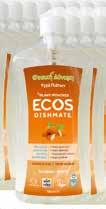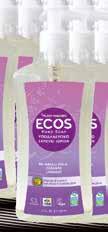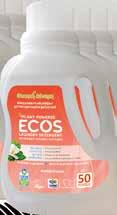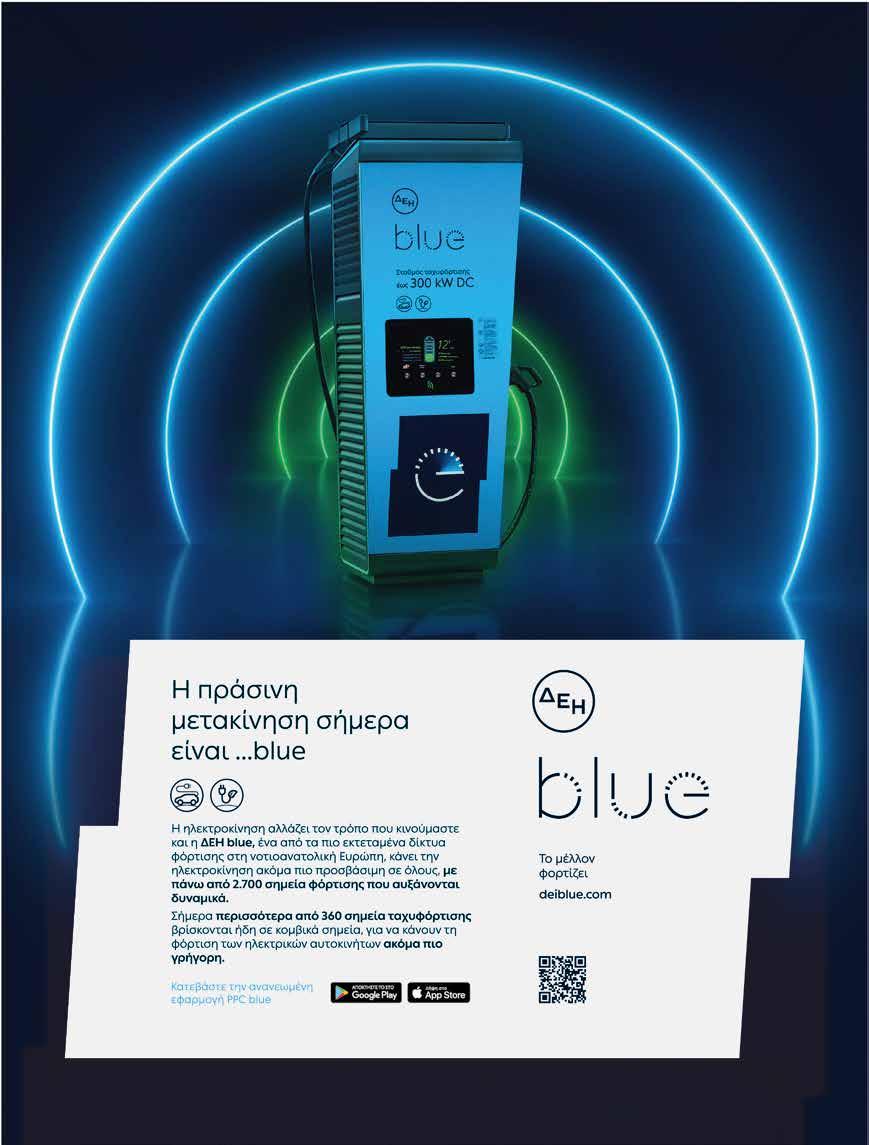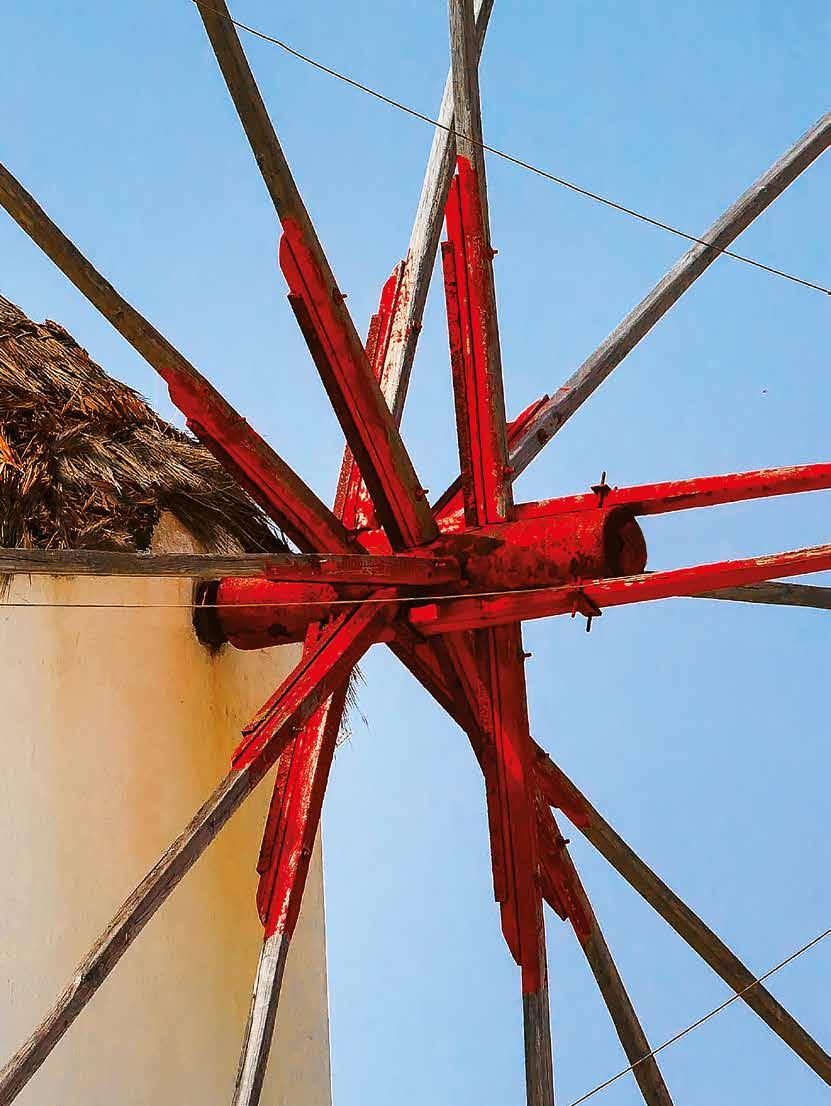




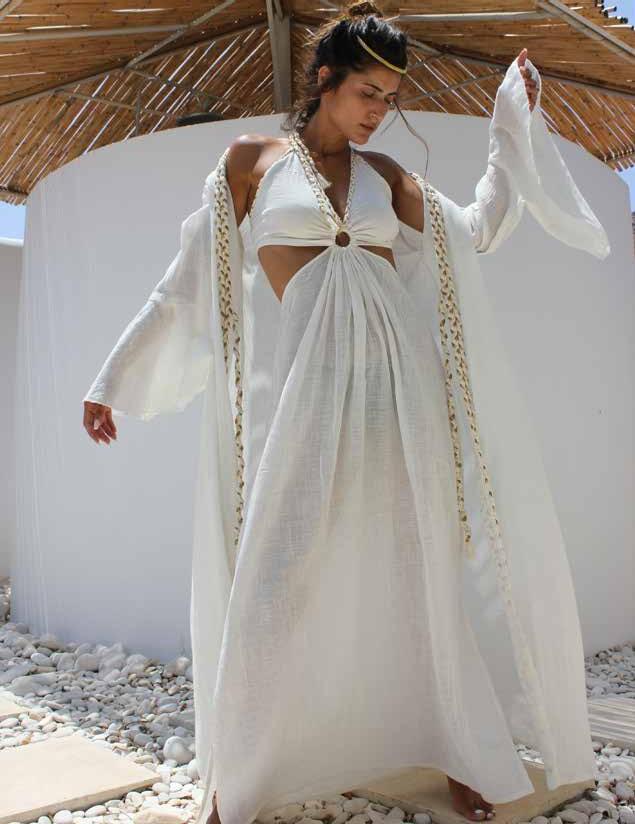







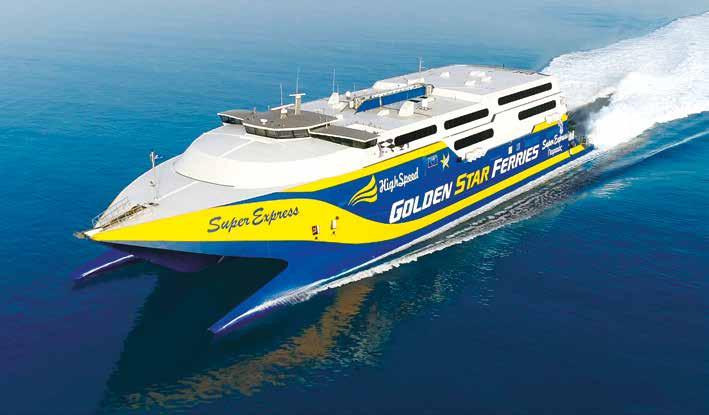
EAver since we returned from last year’s holiday, we haven’t stopped thinking about this year’s destination. And finally, it’s time again to leave daily life, problems and worries behind and set sail for our favourite Cycladic destination.
Cosmopolitan Mykonos, unique Santorini, green Andros, alternative Ios, adventurous Paros and multifaceted Tinos are not just random attractions for visitors from all over the world -their special beauty, diverse activities, vibrant nightlife, stunning beaches and rich culinary scene are bound to leave a lasting impression on everyone.
That’s why we set sail for there. Together. With Golden Star Ferries’s stateof-the-art, reliable ships, which are built to take you safely and comfortably to your favourite summer destination in the Cyclades. No matter which vessel you choose -the majestic Andros Queen, the luxurious Superferry or the fast Superexpress- you can rest assured that you’ll have everything you need to make your trip memorable.
Besides, since 2011, Golden Star Ferries has aimed to turn every trip into a real hospitality experience by offering high-quality transportation services. The experienced crews of its ships are always on hand to ensure your journey is comfortable and carefree, providing a professional and friendly service. Travelling is more than just getting to your destination; it’s the first step of your holiday, the first step towards the unique experiences that await you this summer.
An impeccable experience of travelling by sea and an amazing destination. What else do you need for your journey to be truly memorable? The right
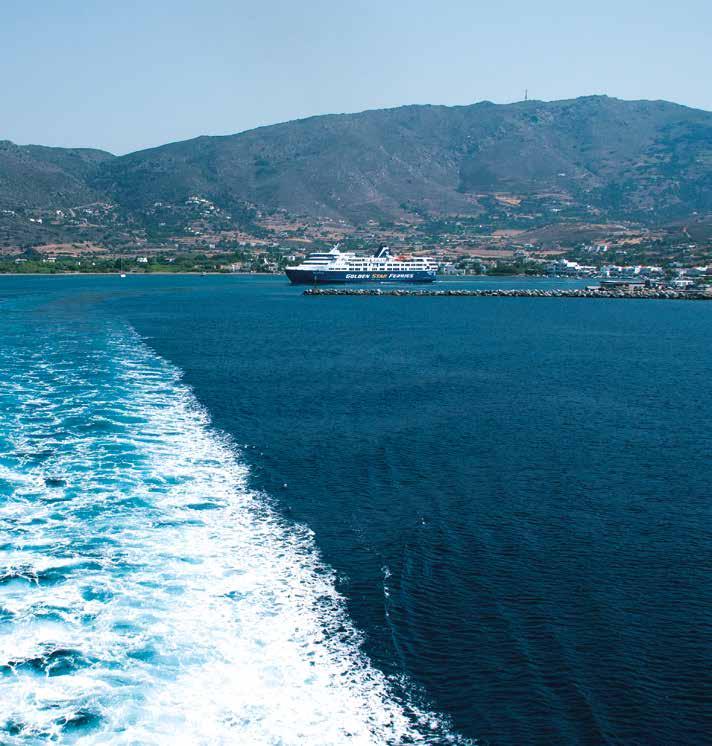
companion, of course! Golden Stars -the magazine you’re holding that will accompany you on your holiday this year. The following pages contain information to help you get to know the destinations, their people, events, culture and gastronomy, as well as featuring interesting interviews with celebrities and prominent figures. It offers a glimpse of what awaits you on the island, and is further proof of Golden Star Ferries’s commitment to providing unique services and benefits to its passengers.
We hope you have a pleasant journey and enjoy a summer full of sunshine, swimming and unforgettable experiences.
EVY TECHNOLOGY® – The Sunscreen Revolution from Sweden
Traveling through the Greek islands under the dazzling sun? Whether you’re soaking up the rays on deck or exploring seaside villages, your skin deserves more than just SPF.
EVY Technology®, powered by patented EVYDERM TECHNOLOGY®, delivers advanced, clinically proven protection that lasts up to 8 hours, even after swimming, sweating, or wind exposure.
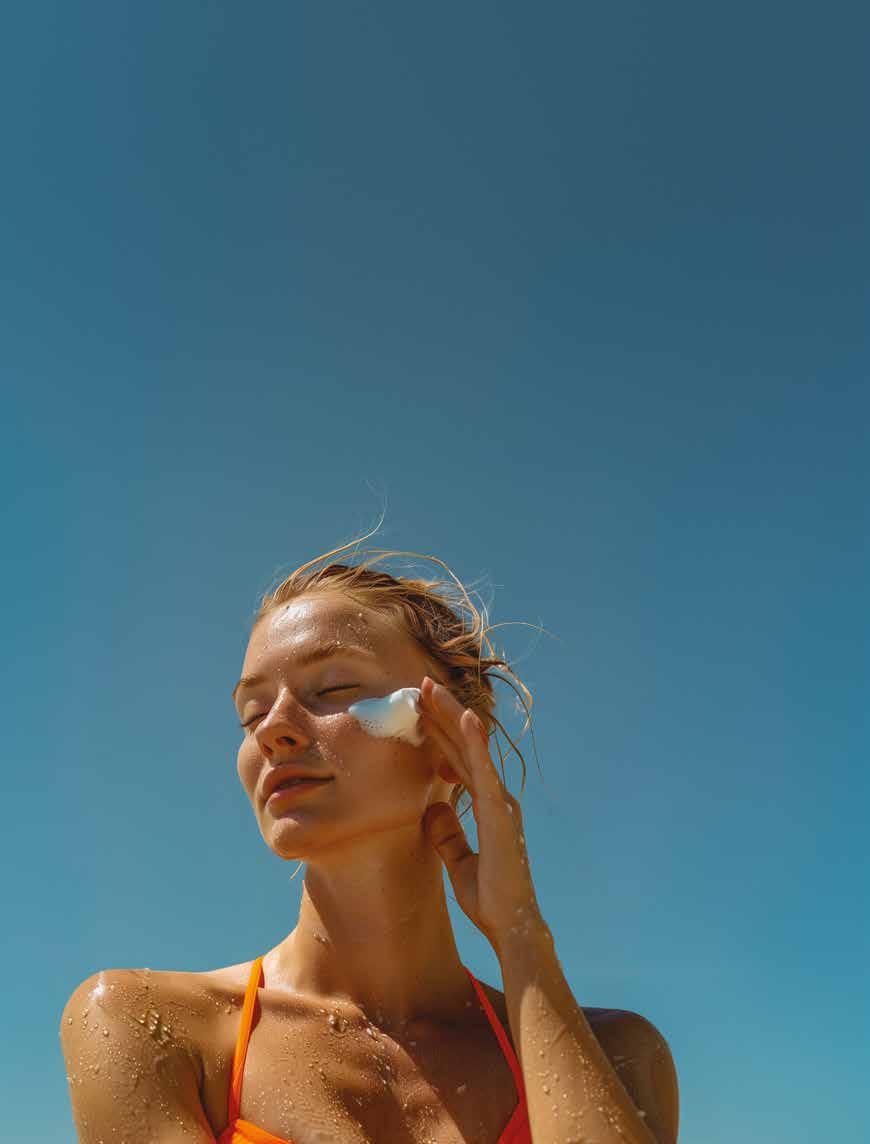

Skin Barrier Repair (helps nourish and rebuild compromised skin)
Wrinkle & Pigmentation Defence (Preserves collagen, reduces fine lines)
Highest UVA Protection Available Rated 90% UVA protection, verified by the Boots Star Rating System (5 Stars) and PA++++ standard
Suitable for all skin types – even sensitive skin
Non-comedogenic, free from parabens, alcohol, fragrance, and allergens


GET IT NOW –QUICK, EASY & SECURE Scan the QR code to explore and order EVY online.



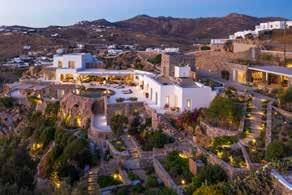
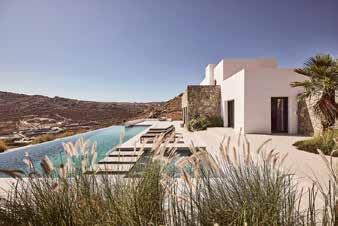





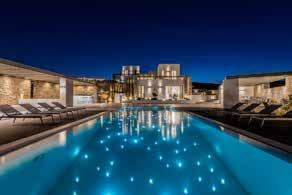

Offices:
Athens: 13-15 Sofokleous Rd, Athens
w w w . r e v i t h i s - r e a l e s t a t e . c o m
D r o s i a : 2 M a r a t h o n o s S t r .
w w w . r e v i t h i s . c o m
Mykonos: New Region Drafaki Rd, (Above Piraeus Bank)
w w w m y k o n o s - r e a l e s t a t e c o m
Arachova: Old Nation Rd
www.parnassos-realestate.com
Vouliagmeni: Astir Marina Vouliagmenis, South Suburbs
w w w . g r e e k t o p v i l l a s . c o m r e a l e




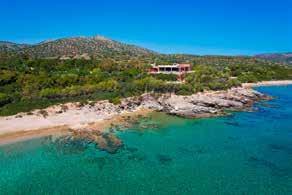



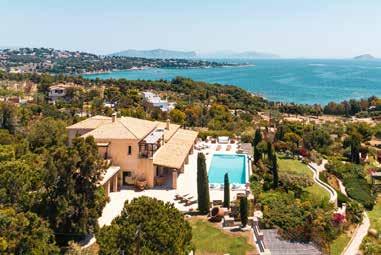


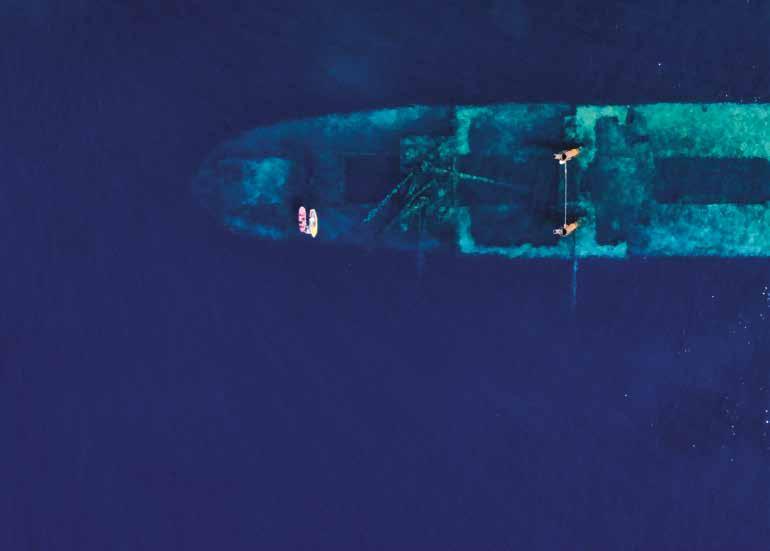

Our passion for exploring this region inspires us to refine each journey, ensuring it reaches its full potential.
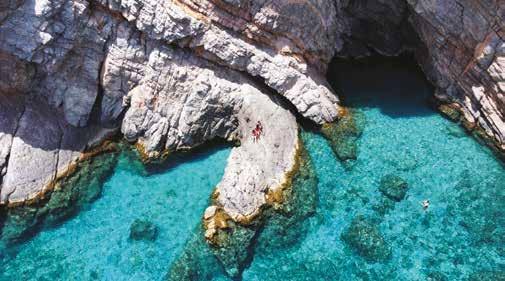
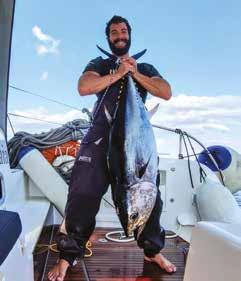
Embark on Aktaia, our Catamaran Lagoon 42 based in Mykonos.
Let us introduce you to this unique cluster of islands through our 7-day sailing journeys driven by the magical Aegean winds.
Re-Discover Cyclades like never before, guided by our skilled professional crew, Cpt. Stergios & Cook Dimitris!.

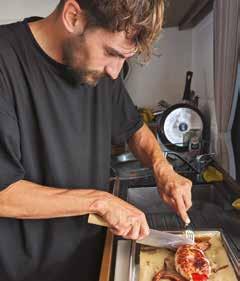
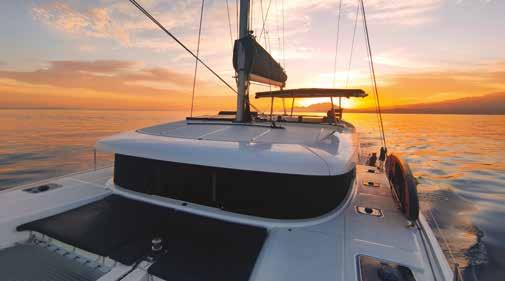
Based on your preferences, we can customize the route to create the most rewarding and enjoyable trip possible.
What defines us:
• Sailing off the beaten landscape, away from the crowds, to our home...the Cyclades
• Experience boat life like never before. Fishing, paddleboarding, snorkeling
• Sharing the true essence of Greek local island life
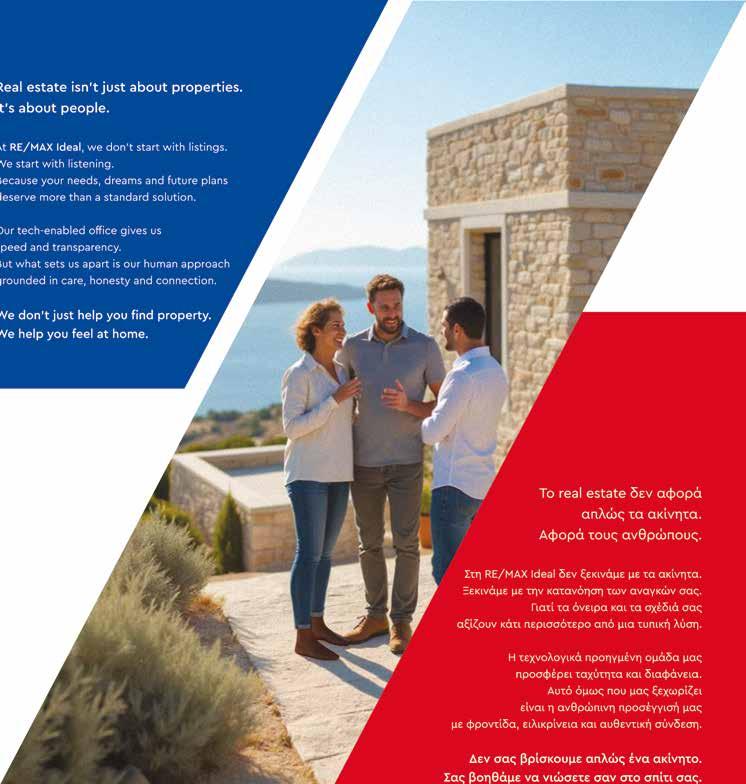






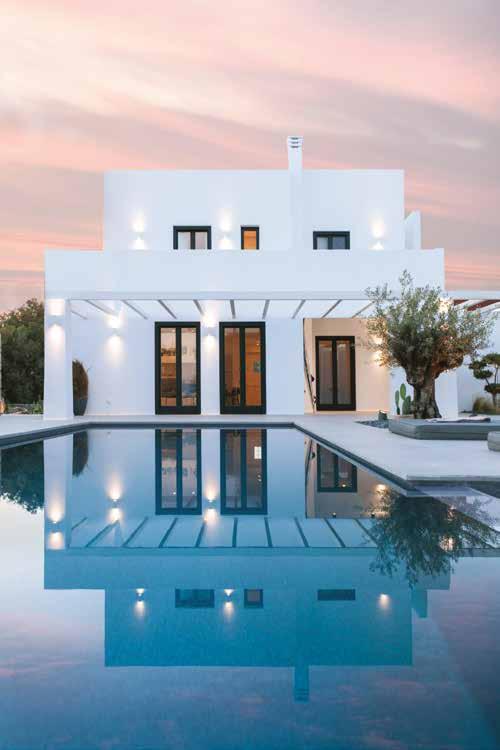
Παραγωγή – Έκδοση PMS MEDIA
037 info@pmsmedia.gr
Creative
Golden Star Ferries Shipping Company
Φίλωνος 133, Πειραιάς Τηλ.: 212 2224000, www.goldenstarferries.gr
Production – Publishing PMS MEDIA
18th km Marathonos ave. & Pilou str., 153 51 Pallini
Τel.: +30 210 3212 037 info@pmsmedia.gr
Managing Director: Xanthi Iliopoulou
Managing Editor: Thanassis Toloudis
Creative Director: Nikos Vatsitsis
Art Director: Alexandros Bitsaras
Contributors: Maria Atmatzidou, Asteropi Lazaridou, Mia Kollia
Copy Editor: Niki Stathia
Translation: Evita Lykou
Photos: Andreas Simopoulos
Commercial Director: Stavros Kefalopoulos
Advertising Managers: Giorgos Andreadelis, Lena Konitsa, Kaiti Konitsa, Marifili Papanikolaou, Stella Selianiti, Peggy Stebili
Printing: PaperGraph S.A.
Your Free Copy
It is illegal to publish, reproduce, or transmit in whole or part of the magazine without the written permission of the publisher. The GOLDEN STAR FERRIES isn’t responsible for the contributors’ opinions as they are represented on issues.
Golden Star Ferries Shipping Company
133, Filonos Str., Piraeus Τel.: +30 212 2224000, www.goldenstarferries.gr

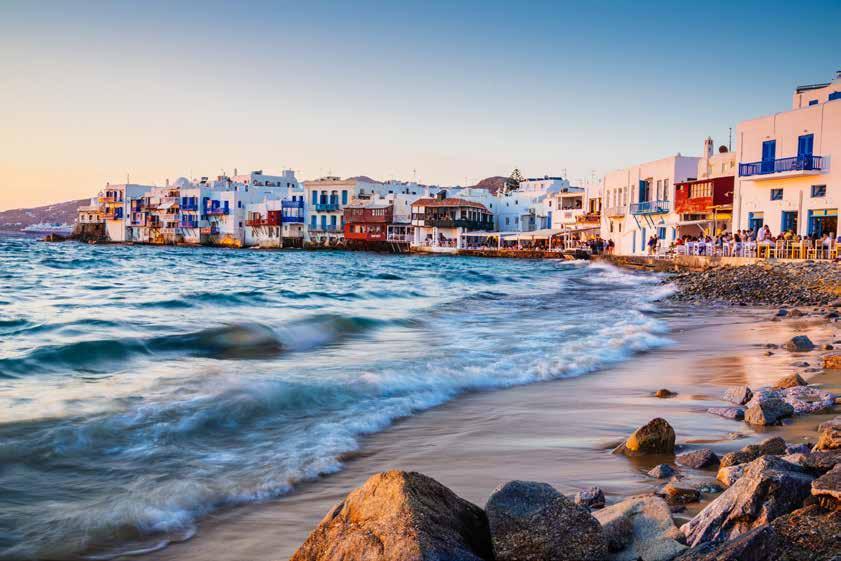


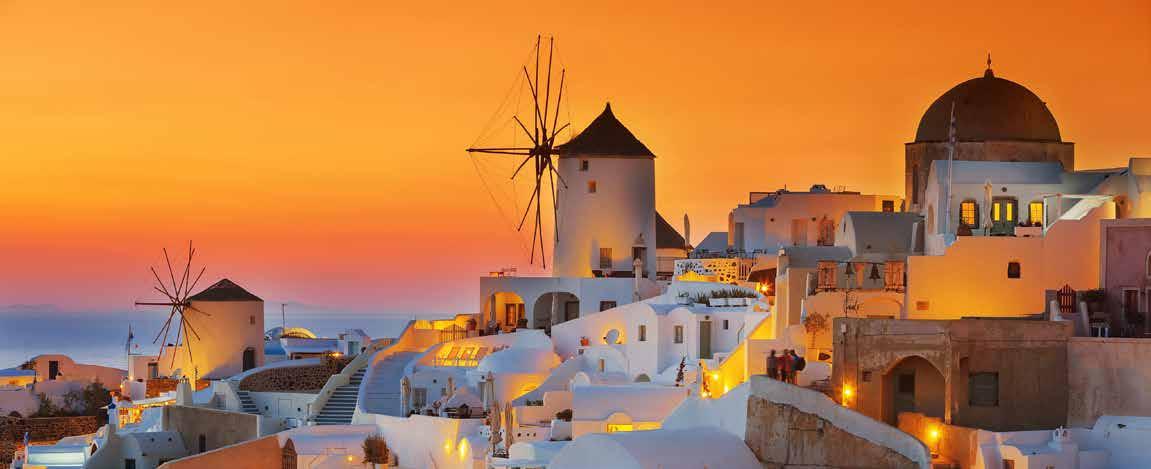






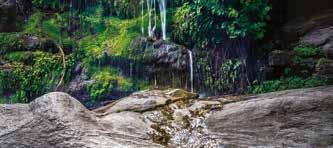



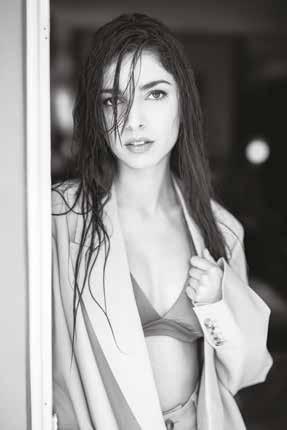
art in the heart of the Aegean
first woman of letters in Modern Greece
to the roots

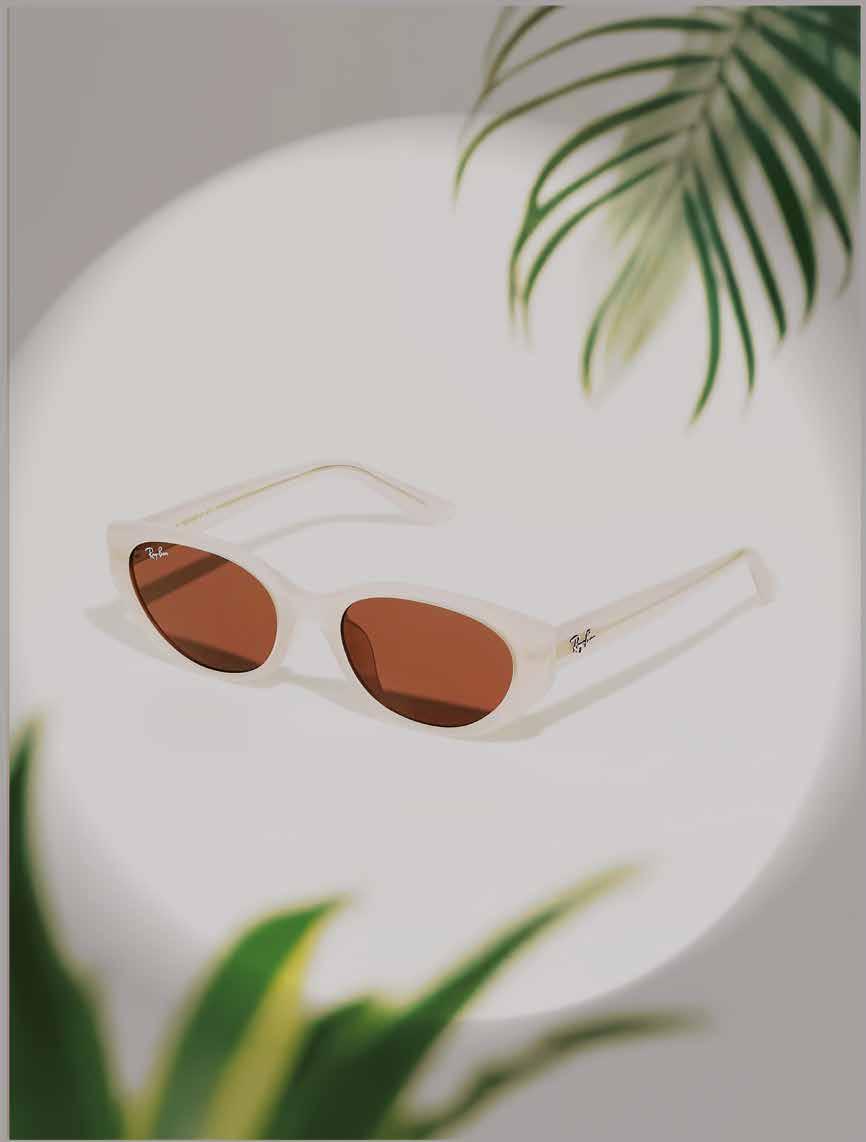

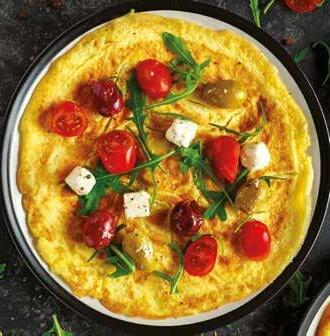
Life & health 114 Μarket

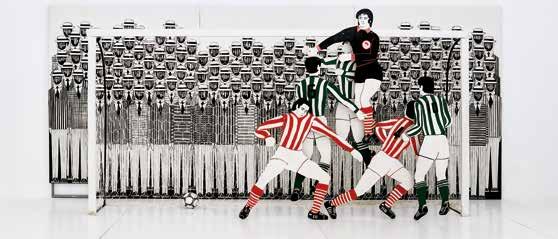

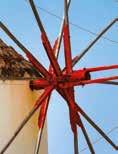


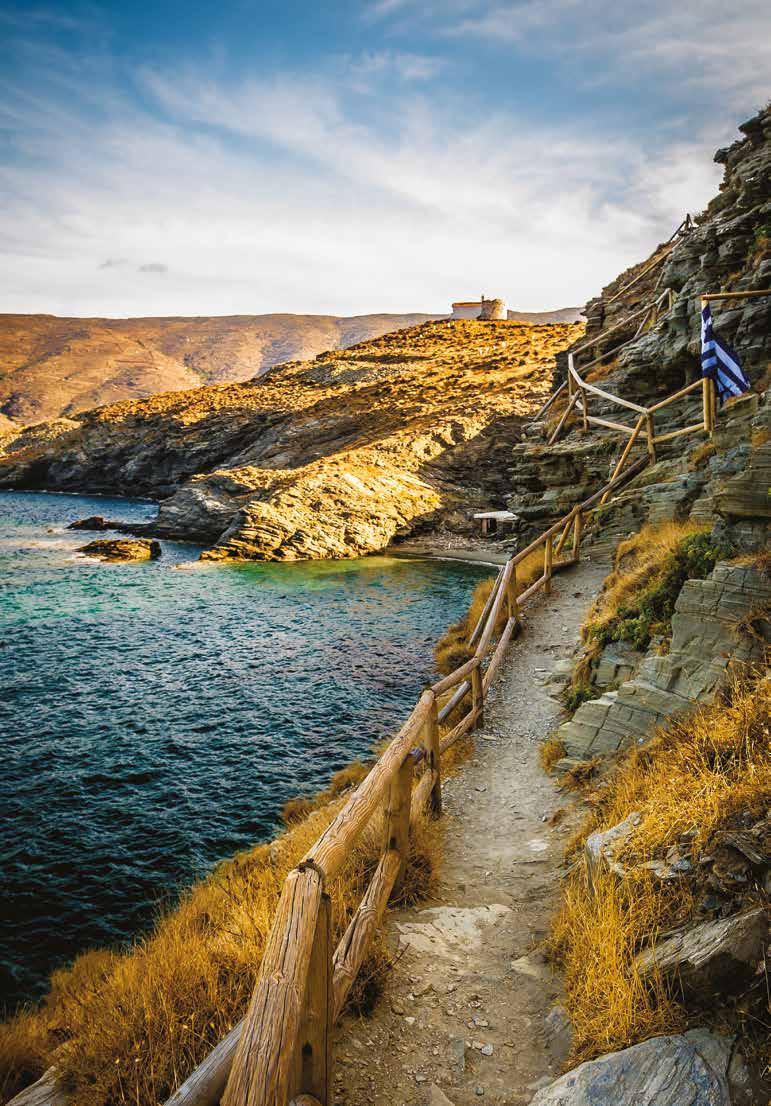
Μονοπάτια για βραβείο
THE GREENEST ISLAND OF THE CYCLADES, ANDROS, HAS BEEN NAMED A PREMIER ISLAND HIKING DESTINATION, BY THE PRESTIGIOUS CONDE NAST TRAVELER.



AHndros is one of the largest islands in the Cyclades (second only to Naxos) and, in addition to its many interesting beaches, holds a wealth of inland surprises. Among them is the wide variety of hiking trails, which made it a top island destination for hiking, according to the famous travel magazine “Conde Nast Traveler”.
The lush green island of the Cyclades has an impressive network of hiking trails covering more than 500 km. The network is spread across the island and connects old and new settlements with rural areas, places of worship, ravines, valleys, harbours and beaches. Some 240 km are fully signposted to European standards, so hikers can see exactly where they are and where they are going.
With more than 25 hiking routes certified by the European Confederation of Hiking Clubs since 2015, Andros is the only island in Europe to have this certification.
The benefits of walking are many, as in addition to the necessary physical exercise, it offers mental clarity, peace of mind, and a much more meaningful connection to the place you are visiting. Furthermore, the exploration of the dozens of hiking trails of the island offers unique experiences to the hiker.



από
Breathtaking views from the peaks of the island’s mountain ranges, rivers (Achla, Vori, Pythara), impressive waterfalls, traditional bridges, water mills, cool springs, imposing monasteries, hundreds of chapels scattered throughout the island and beautiful valleys reward those who choose to discover the natural riches of Andros.
There are exciting routes with varying degrees of difficulty, both for experienced hikers and for novice hikers who wish to take their first adventurous steps. One of the hidden secrets that can be discovered by the hiker is in the mountains of Andros and it is called Gerolimni. Those who have made it say it is an unforgettable experience that may be difficult for the would-be visitor, but is definitely worth it. It is a beautiful lake surrounded by dense vegetation and has an impressive waterfall.
So, in addition to your summer shoes and accessories, don’t forget to pack your mountaineering gear for unforgettable hikes that will give your holidays a whole new meaning!

ΕΡΕΘΙΣΜΕΝΟΣ

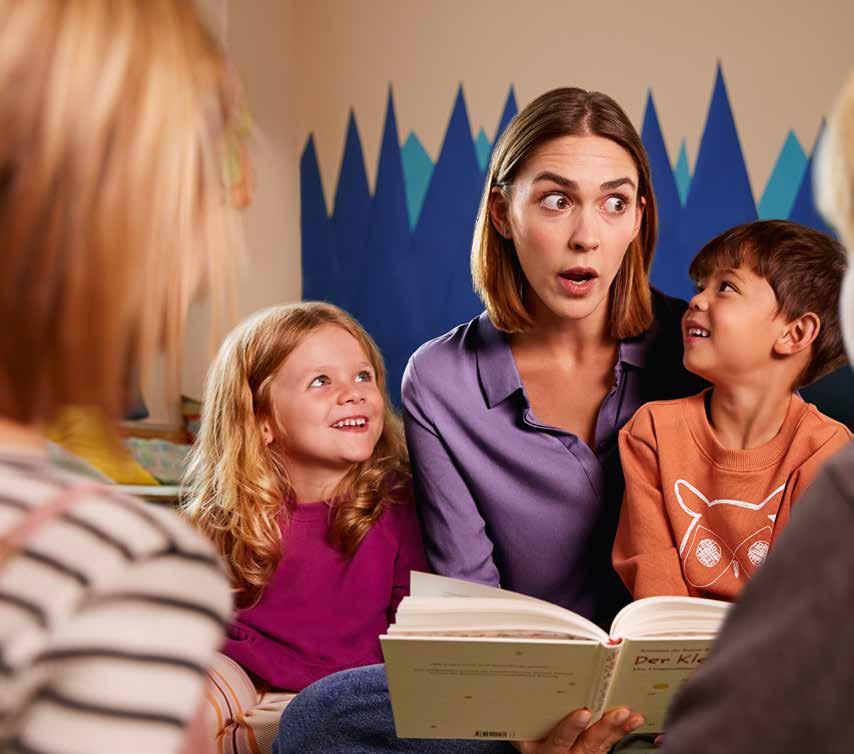
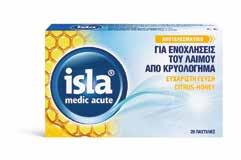

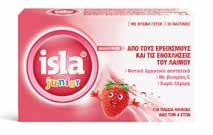

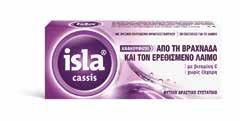



FOR 30 YEARS, RARITY GALLERY IN MYKONOS HAS MAINTAINED THE UNDIMINISHED INTEREST OF VISITORS, COLLECTORS AND ART LOVERS. THIS YEAR, IT IS ATTRACTING ALL EYES WITH A GROUP PHOTO EXHIBITION FEATURING INTERNATIONALLY ACCLAIMED CREATORS.
Today, Kalogera Street may be the Mykonian version of Saint Honoré or Sloane Street, with stores like Gucci, Dior, and OffWhite. However, in 1995, when Christos Nikolaou and Vassilis Matsaidonis decided to open the Rarity Gallery, the island had a completely different character.
In a narrow street lined with houses with small courtyards



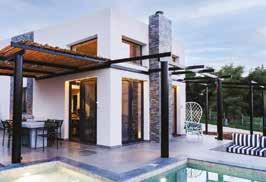



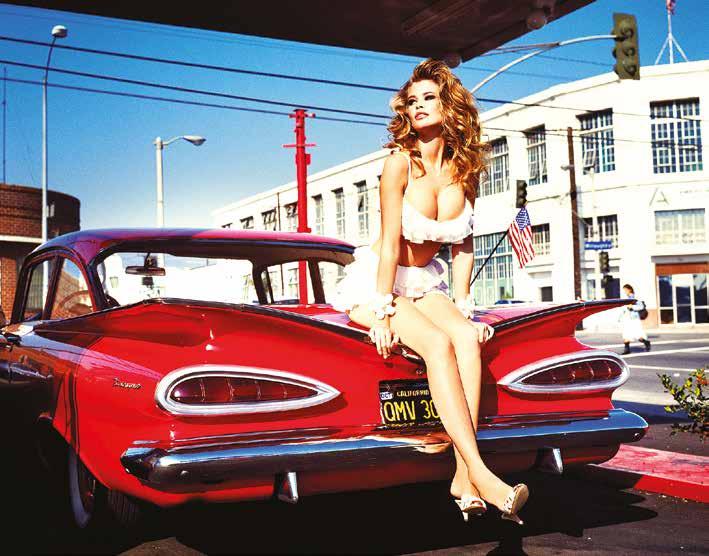

and small shops, the creators established one of the most influential contemporary art spaces in the Aegean. Thirty years later, it continues to pioneer and attract art lovers and collectors.
It was the first gallery in Greece to showcase a selection of works by world-renowned contemporary artists. “From the beginning, their personal knowledge of art has provided an innovative and curated aesthetic experience, with the aim of enhancing the public’s appreciation of contemporary international art”, says someone knowledgeable about both the island and art.
“In its thirty years of operation, Rarity Gallery has gained a reputation for presenting exhibitions of contemporary, museum-level art featuring works by renowned international artists and young talent”, continues our artistic source. “Rarity Gallery was the first in Greece to begin presenting -and continues to present- works by distinguished international artists whose work is
Ellen von Unwerth.
Tony Cragg.
H Above: Claudia Schiffer photographed by Ellen von Unwerth.



included in the permanent collections of prominent international museums and art exhibitions, as well as in corporate and private collections”.
From the impressive setting of the early twentieth-century Mykonian mansion with its five halls, have paraded distinguished artists and famous works: The unique sculptures of Marc Sijan, the vibrant paintings of Natalie Westbrook, the photographs of David LaChapelle and the abstract pieces of Julian Opie -whose work is currently on display at the Moco Gallery in London- as well as the whimsical sculptures of Philip Colbert, who exhibited at the Saatchi Gallery in London earlier this year.
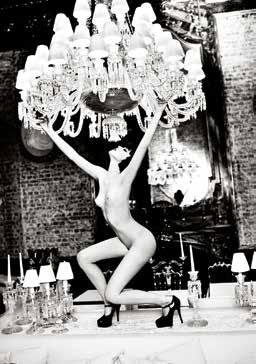
The works in the five galleries converse with each other, each following a separate thematic narrative while maintaining continuous visual communication. It’s a difficult undertaking, but they seem to achieve it every year. There you will find kids who want to be inspired, art lovers who want to be informed and collectors who want to acquire the works.
How are artists selected? “Upon entering the
H Above: Works by renowned photographer David LaChapelle in the gallery.
Left: Another iconic photograph by Ellen von Unwerth.
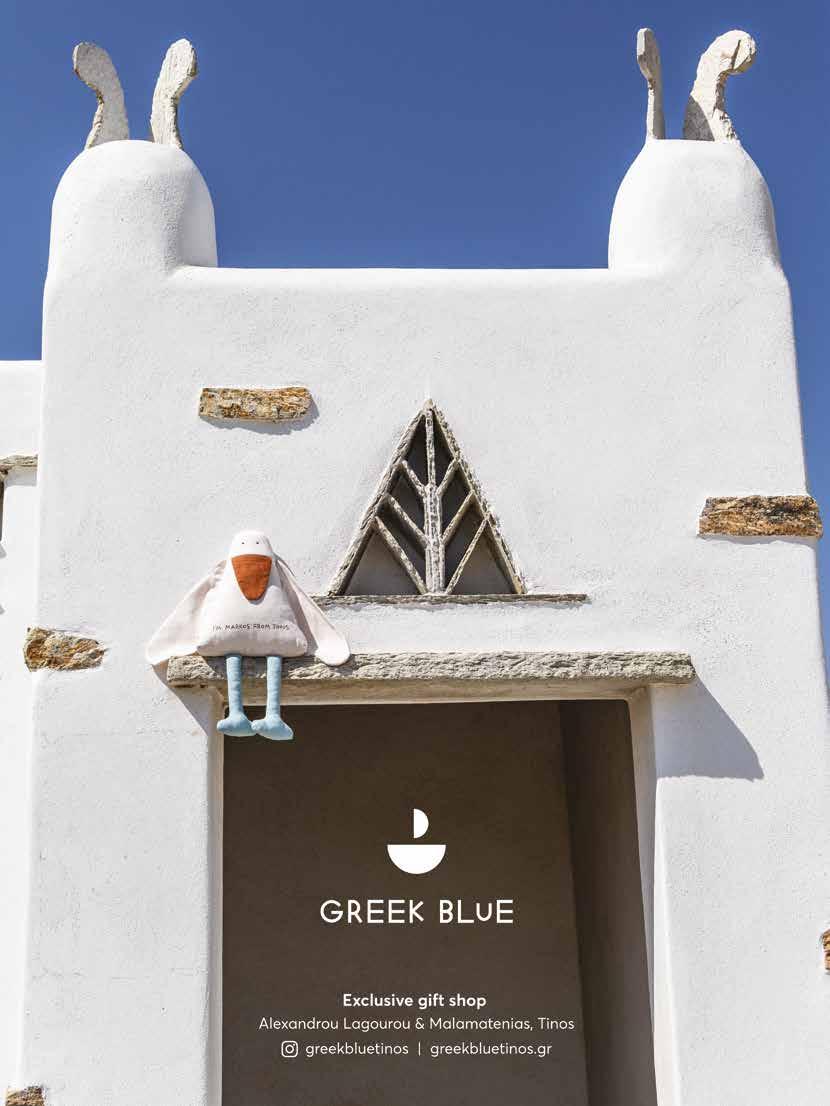

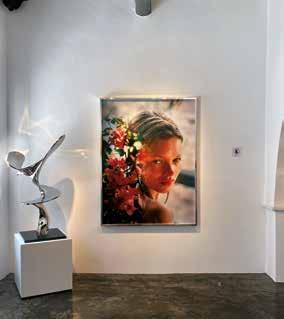
οι David LaChapelle, Ellen von Unwerth, Yves Scherer, Mat Collishaw και Jeff Robb,
Moss, Claudia Schiffer, Beyoncé, Leonardo DiCaprio και Madonna, αποκαλύπτοντας άγνωστες πτυχές των πολυδιάστατων
Cragg, Peter Halley, Christopher Le Brun, Philip Colbert, Charlotte Goldsmith, Massimo Listri, Massimo Vitali
Peter Zimmermann.

Αριστερά: Η Claudia Schiffer
Yves Scherer
Julian Opie.
Peter Halley και Hunt Slonem.
H Left: Claudia Schiffer by Ellen von Unwerth, and a photo of Kate Moss by Yves Scherer, both on display at the gallery.
Below left: Works by Julian Opie.
Below right: Works by Peter Halley and Hunt Slonem.
gallery, it’s clear that the artworks on display were chosen based on aesthetics, quality, timeless artistic value, and dynamic investment potential” note the owners.
This year, they have prepared a real celebration of contemporary art. From 1 May to the end of September, a legendary group exhibition will be held, featuring thirty photographs by internationally acclaimed artists such as David LaChapelle, Ellen von Unwerth, Yves Scherer, Mat Collishaw and Jeff Robb who will be exhibiting a unique hologram of Queen Elizabeth II created to celebrate her Diamond Jubilee. It is a landmark piece of contemporary art because it was created with the Queen’s consent, who was photographed by Chris Levine and very much enjoyed the process. Robb’s magical hands gave it a three-dimensional form.
“This is a rare opportunity to acquire selected works, including some unpublished photographs, from the personal archives of artists who have made an indelible mark on contemporary photographic art. The artistic photographs, both colour and black-and-white, on display capture a mesmerising intersection of time, place and personalities. They depict legendary figures such as Queen Elizabeth II, Kate Moss, Claudia Schiffer, Beyoncé, Leonardo DiCaprio and Madonna, and reveal unknown aspects of the photographers’ multidimensional talents”, note the owners. The exhibition will be enriched during the summer with paintings and sculptures by international artists, including Tony Cragg, Peter Halley, Christopher Le Brun, Philip Colbert, Charlotte Goldsmith, Massimo Listri, Massimo Vitali and Peter Zimmermann.
www.raritygallery.com


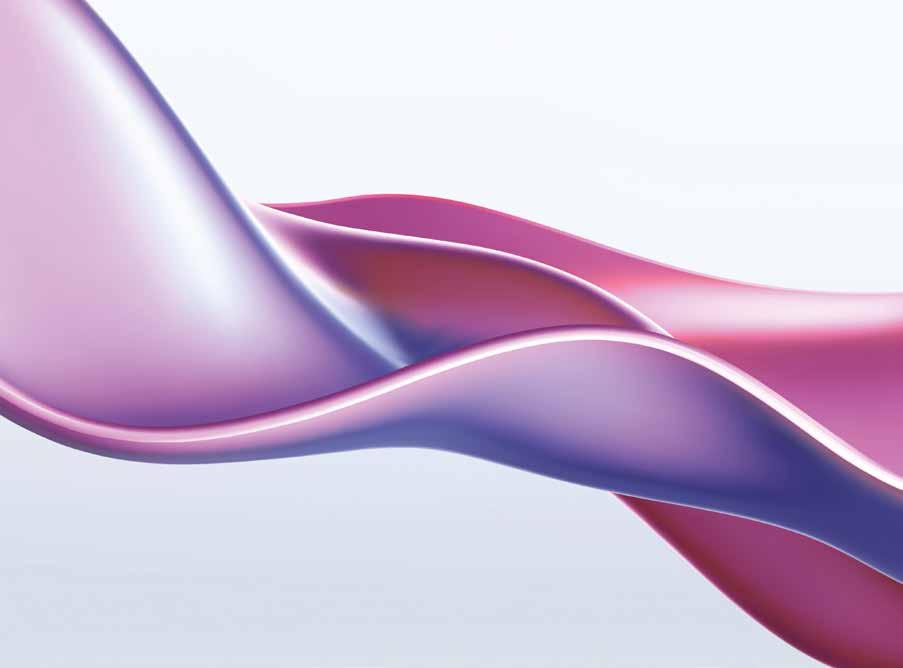




Η πρώτη
διανοούμενη
Ελλάδας
Η
EVANTHIA KAIRI, FROM ANDROS, IS CONSIDERED ONE OF THE MOST PROMINENT FEMALE FIGURES OF THE 19TH CENTURY, WITH A FIERY AND PIONEERING SPIRIT FOR HER TIME.
LET’S GET TO KNOW HER BETTER!
MARIA ATMATZIDOU
Born in Andros in 1799, Evanthia was the last child of her noble and large family. Deeply admiring her brother, the scholar, philosopher, fighter and priest Theophilos Kairis, she followed him to Kydonies (modern day Ayvalık) in Asia Minor in 1812, where he had been invited to teach at the renowned Academy. There, 13-year-old Evanthia studied ancient Greek, mathematics, physics, astronomy, philosophy and foreign languages. The more she satisfied her thirst for learning, the greater her desire to share her knowledge with others, particularly girls. At the age of 15, she found the courage to write to Adamantios Korais -known as the “Teach-
Detail from the cover of “Nikiratos”, a play written by Evanthia Kairi.


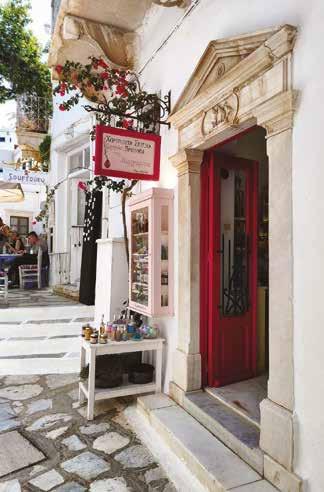
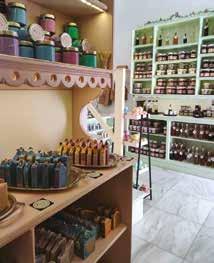
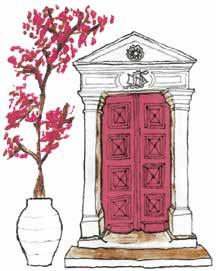
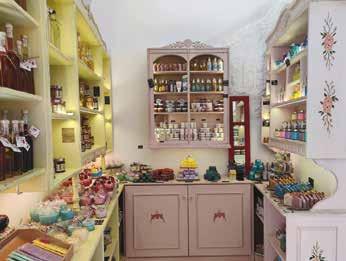
Margarita’s Handmade Homemade Products began their journey in Pyrgos, Tinos, in 2017.
As you approach the village square and the shade of the plane tree, you will be welcomed by the aromas of our handmade soaps and candles. Here you will find a wide range of herbal cosmetics, as well as traditional savoury and sweet flavours. Crafted with love and care, they invite you to embark on an exploration from yesterday to today.
We are here to help you with your choices.
Tinos Pyrgos, 84201, Greece Tel.: +3022830 31885 www.tismargaritas.gr
H Right: “Nikiratos” -the first printed play written by a woman.
Below left: Adamantios Korais, the Teacher of the Greek Nation.
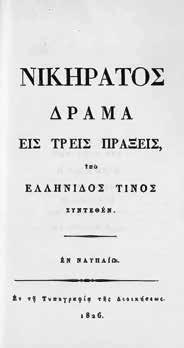
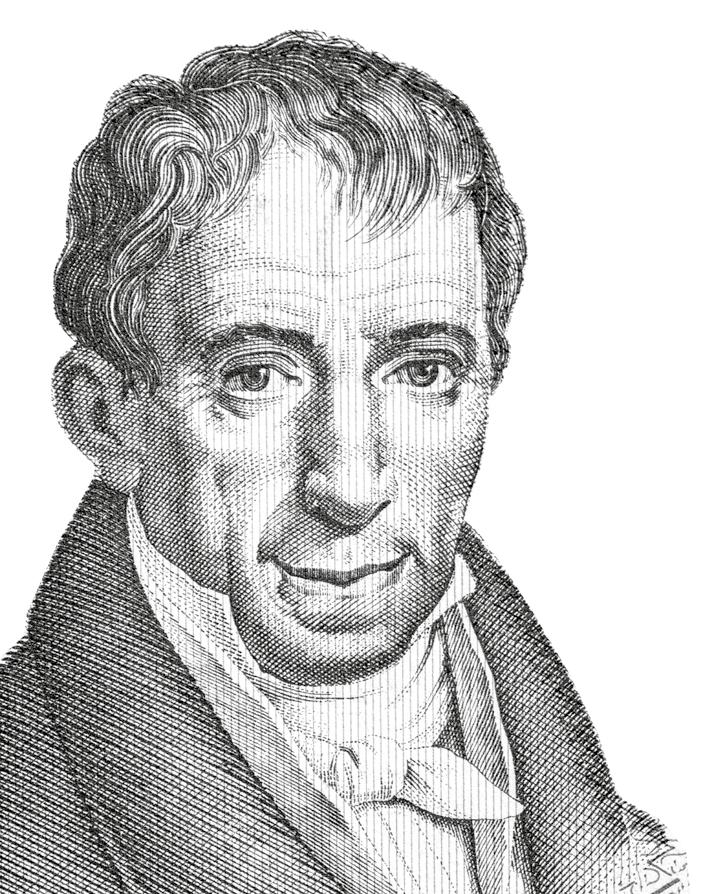
er of the Greek Nation”- and asked him for books to translate into Greek. Korais, a wise man of the Enlightenment, admired her intellectual gifts and was deeply moved by her zeal. He sent her books and offered her advice. Evanthia translated François Fénelon’s treatise “On the education of daughters” and later the “Eulogium on Marcus Aurelius” by Antoine Léonard Thomas. Korais held her translational and rhetorical skills in high regard, and the foreign travellers and scholars who met her had only good things to say about her. She was described as brilliant, educated, sparkling, noble and beautiful. She was also shy and reserved -despite receiving marriage proposals, she never married. She was concerned about the education of women, who were condemned to ignorance, but also about the preparations for the great liberation struggle of enslaved Greece. While Theophilos was initiated into the Society of Friends (Filiki Eteria), Evanthia attempted to enlighten the young women. She was the one to recognise the contribution of women to the struggle for freedom. In the preface to her translation of the treatise “A Father’s Advice to His Daughter” by Jean-Nicolas Bouilly, Evanthia passionately refers to women’s patriotism. In turn, they write to her from all over Greece, begging her to teach them how to escape the shackles of illiteracy.
In June 1821, the Turkish army destroyed Kydonia. The two siblings return to Andros. While Theophilos was travelling for the needs of the revolution, Evanthia lived with her brother, Dimitrios, in Ermoupoli, Syros, starting in 1824. There, she continued teaching and fighting for independence. In 1825, she wrote an explosive letter to Philhellene women across the Western world, urging them to support the just cause of the Greeks. In this powerful text, signed by other prominent women of the time, Evanthia condemns the neutrality of the European powers as the

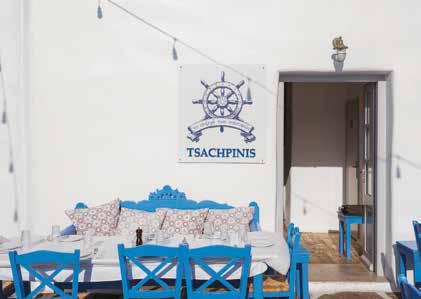
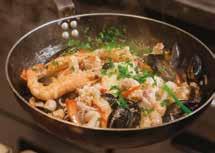






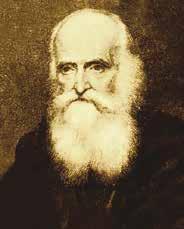

H Left: Theophilos Kairis.
Top right: “The Exodus of Missolonghi”, painting by Theodoros Vryzakis.

greatest of Greece’s sufferings, likening it to “inhumanity” and “atrocity” on behalf of those who boast about being born in “wise Europe”. Evanthia was deeply moved by the heroic exodus of Messolonghi in 1826. Inspired by the self-sacrifice of the people of Messolonghi, she wrote “Nikiratos”, the first play dedicated to the Greek Revolution to be written and published by a woman. The play had a huge impact -it was first performed in Syros and then in other parts of Greece. It seems that she never attended the performances herself. She did not even sign her work -it was the Fanariot prose writer and poet, Alexandros Soutsos, who revealed her name in an article in 1827.
Following the liberation, Theophilos campaigned for the establishment of an orphanage in Andros, where war orphans would receive much-needed care and education. In 1839, Evanthia followed her brother again to help him with his work. However, as he introduced new teaching methods and religious theories, he faced harsh criticism from the Church, which labelled him a heretic. After enduring many hardships, he ended up in the prison-purgatory of Syros, where he died (in 1853) just days before being acquitted by the Supreme Court. Even his remains were brutally treated by his opponents. Immersed in grief and sorrow, Evanthia withdraws from life. She remained isolated and in dire financial straits in Andros until her death in August 1866. Although she avoided the spotlight -no images of her have ever been found-, she played a leading role during a particularly turbulent period. And she was a leading figure with clear political thinking and a beacon of hope for women who were trying to break free from the stereotypes of the time -and to assert their place in society.
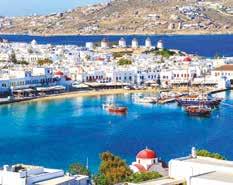
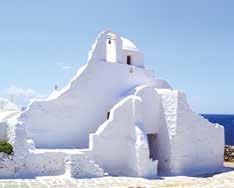


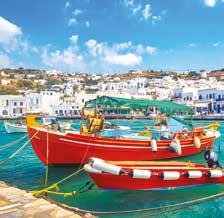

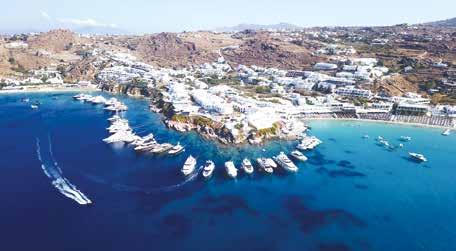



ARTIST ANGELIKA VAXEVANIDOU IS A WOMAN OF INFINITE TALENT, DEEP KINDNESS AND A WILLINGNESS TO EXPERIMENT. SHE LIVES IN PAROS BY CHOICE, WHERE SHE CREATES WONDERFUL WORKS AND DARES TO USE SURPRISING TECHNIQUES.
KOLLIA
A mini life story: Ηow did you arrive in Paros and what does the island mean to you?
My connection to Paros began long before I lived here. My grandmother was born in Lefkes, a mountain village on the island. Growing up in Athens, I often listened to her stories about village life, the landscape, and traditions. Her words painted pictures in my young mind and made me dream of seeing it all for myself. After finishing my Fine Art studies, I felt drawn to the Aegean, and in 2004, I made the decision to move to Paros. Now, more than twenty years later, the island has become so

Memi Papakonstantopoulou
FINANCE & TAX CONSULTANT
PROJECT
MANAGER

(Business Plan, Feasibility Studies, Execution)
Real Estate Project Manager
TAX Advisor
ACCOUNTING Services for Companies (SA, LTD, Personal, etc)
Bank,Private Institution Financing
HRM-Payroll-Labor Law issues
PR-Marketing-Sales
Legal Services
NPL Restructuring &Refinancing
ESPA( European Grants) Project
2 Pallados str., 84200, Chora, Tinos, Cyclades Agios Romanos, 84200, Tinos, Cyclades T.: +30 22830 25980 - 1, +30 6947 904 495
23-25 Eponiton str., Alimos 17455, Athens T.: +30 213 0308 985, 211 1188 656, 211 0010 086
Email: info@memitinos.email, info@mpfinance.group, info@mpfinance.tax www.mpfinance.tax
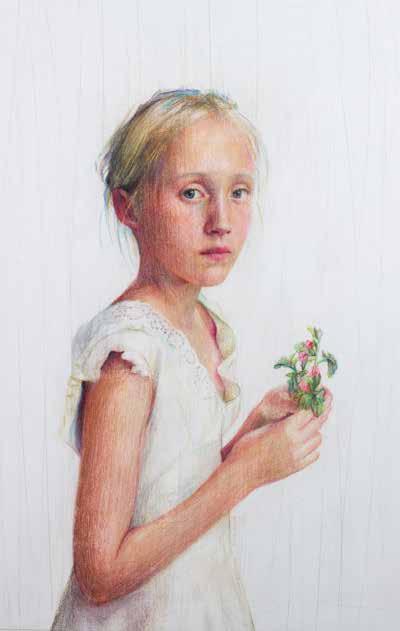

much more than a childhood dream. It’s where I’ve built my life -raised a family, developed my practice, and grown in ways I never expected. Together with my husband, we built our home in the mountains and established my studio in Lefkes. Though my grandmother is no longer with us, I often think of her as I walk the same paths she once did. Living and working in this place connects me to a deeper rhythm of life.
How big a difference does it make for someone who paints to live outside the cities?
The biggest difference is the lack of distractions. Without the constant noise and pressure of city life, there’s more space -mentally and physically- to focus. There’s a kind of stillness, a quiet breathing room that’s really valuable for creative work.
Of course, that space comes with its own challenges. There’s less access to exhibitions, fewer cultural events, and fewer chances to connect with other artists. You have to find your own way and become more self-reliant. For me, that’s meant sharing work online, and more recently, creating an exhibition space in my studio. It’s not always easy, but there’s a kind of freedom in it. You’re less influenced by trends and





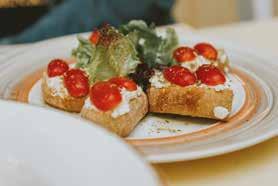
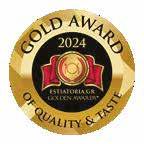
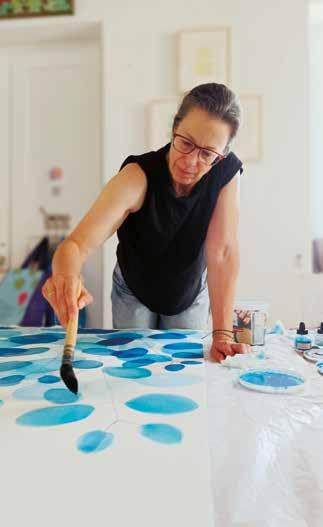
outside expectations, and I think that independence often makes its way into the work.
How did you start painting?
I’ve been drawing for as long as I can remember. Even as a child, art was how I made sense of the world. In kindergarten, I used to draw on the desks -and the worst punishment was being told to wipe them clean. Erasing my work felt like erasing a part of myself. After high school, I studied Fine Art in Athens, then continued my studies in Berlin and Munich. Those years of study really helped to expand my perspective and gave me the tools to push my work further and with more intention. From there I started to develop the practice I have today.
What is the main theme or pattern that inspires you the most and how do the themes emerge each time? Identity is a recurring theme in my work -especially the question of who we are beneath all the social expectations and learned behaviours. I’m fascinated by what’s left when all that is stripped away. What do we still carry? What do we reveal -or hide- even from ourselves? And what possibilities open up when we stop performing or conforming? There’s a kind of freedom in that space -a sense of something honest, something essential. That’s what draws me in: the idea that if we step outside what we’ve been taught to be, we might discover something more real -not just as individuals, but as part of a shared human experience.

Do you mainly use a specific technique or do you like to experiment?
The techniques I use depend on what I’m working on. If I’m sculpting I might use clay to create forms which can then be replicate using bronze or other material.
Recently, I’ve been creating works using cotton threads. The local women in the village make beautiful, intricate crocheted patterns and designs to decorate their homes. I asked them to teach me the techniques and knots they use, and I began developing three-dimensional forms of my own. I call these pieces “Objects of Desire”.
But drawing is still my favourite medium. I think it’s the most honest and direct form of expression. What you put on the paper is all there -nothing to hide behind. You expose your thoughts, your feelings. It’s vulnerable. I draw with graphite, coloured pencils, pastels, inks -but mostly, I love charcoal, especially for large-scale portraits. I’ve developed a tech-



nique where I use the charcoal like a needle, threading lines across the paper. I weave these lines together to form the figures. It’s almost sculptural -a way of stitching presence into the surface.
Are there any works that you consider more personal or significant -either for the subject matter or the moment in which they were made? I feel a strong connection to all my work, but some pieces definitely feel more personal. It’s usually not just about the subject, but about what was happening as I made them -the emotions that surfaced during the process. Sometimes I don’t realize how much a piece means to me until it’s finished. Then, when I step back, I notice it quietly stays with me longer than the others. Some of my favourite works are portraits. There’s something about drawing a face that pulls out things you didn’t expect -memories, feelings, even questions.
angelikavaxevanidou.com
angelikavaxevanidou.com

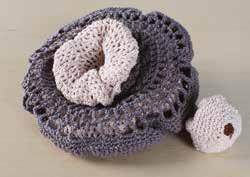
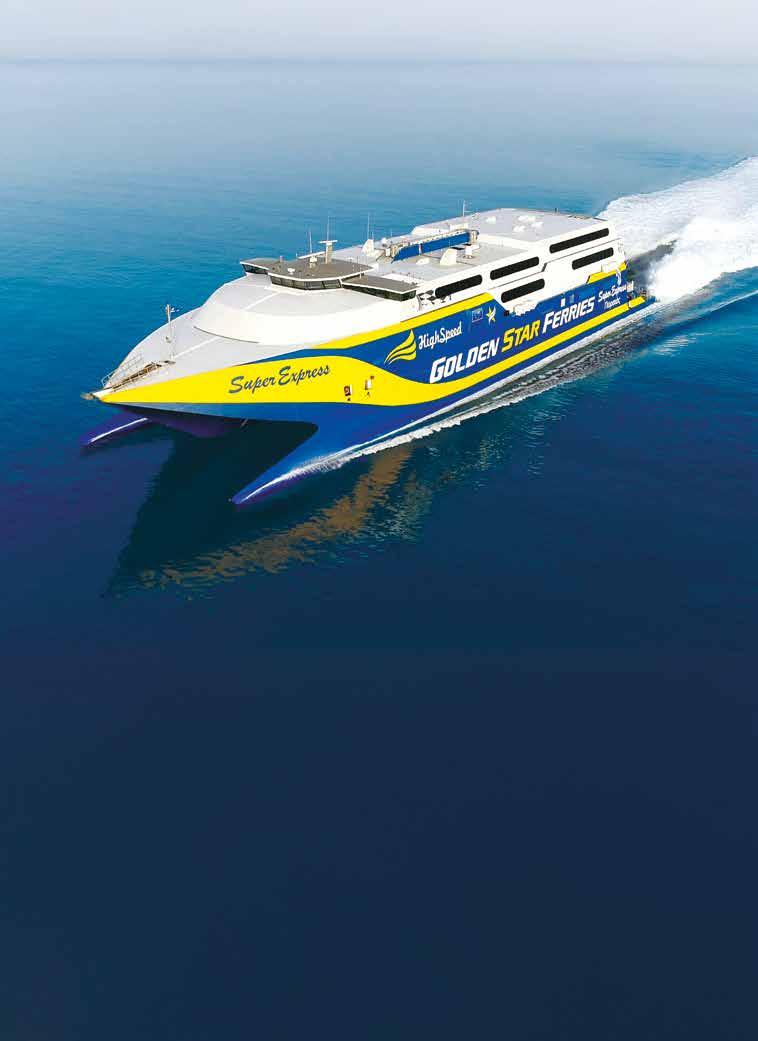


THE SANTORINI PHOTOGRAPHY GROUP PRESENTS AN EXHIBITION CELEBRATING THE BEAUTY AND UNIQUENESS OF THE CYCLADIC ISLAND.
ne of the most photogenic islands in the world is presented through the lens of 34 talented artists. The Santorini Photography Group (FOS) presents the exhibition “Santorini in the Light” at the Kastelana Photography Centre, at the entrance of Kasteli, in Pyrgos, Thira. The exhibition, which will run until 22 June 2025, showcases the work of 34 local artists. It is the culmination of the group’s collective
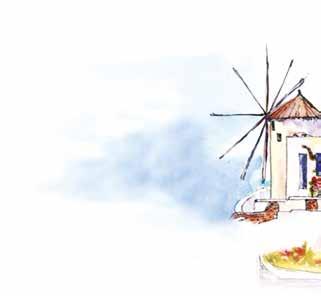
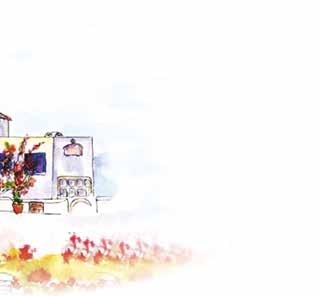

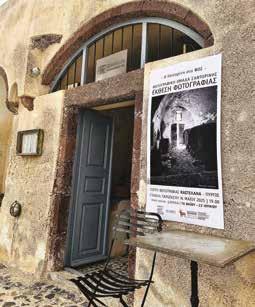
efforts and a creative way to promote Santorini by offering an authentic and sensitive perspective.
The photos capture the island’s unique beauty and cultural significance, as experienced by its residents who wanted to showcase it through their photography.
The Santorini Photography Group seeks to contribute substantially to the promotion of the place’s authenticity through the power of the image and sensitivity in recording everyday life. The insightful perspective of its members illuminates the most authentic aspects of Santorini, from moments and faces to landscapes.
The photographers offer visitors a deep and personal perspective of Santorini that is far from stereotypical, thanks to their unique artistic vision.
The exhibition is part of the activities of Thira Municipality for the “Year for the Promotion and Support of Authenticity 2025”.

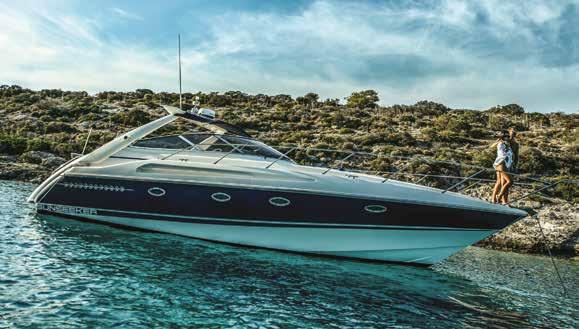



The Santorini Photography Group is an open, amateur group for anyone who loves photography and wants to express themselves creatively on the island.
As for the very special venue hosting the exhibition, the three-storey building of the Kastelana Photography Centre is part of the main entrance of Kasteli, the medieval fortified settlement of Pyrgos, Santorini. The interior remains unaltered, complete with original furniture, and is a prime example of a residence within the fortification. Meanwhile, the exterior spaces offer stunning panoramic views of the island. The Photography Centre’s mission is to support and promote photography as a form of artistic expression and a means of documenting the world. Its primary activity is organising exhibitions of contemporary and archival photographic work.
Various exhibitions and activities are planned for this summer, including a presentation of images of Santorini from the period 1925-1930 by the famous photographer Nelly’s. This historical perspective will

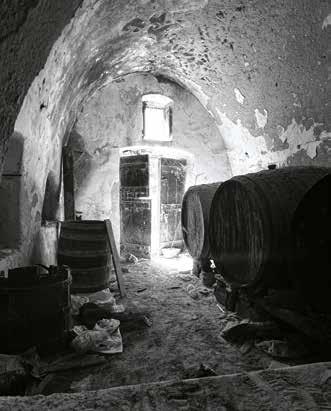
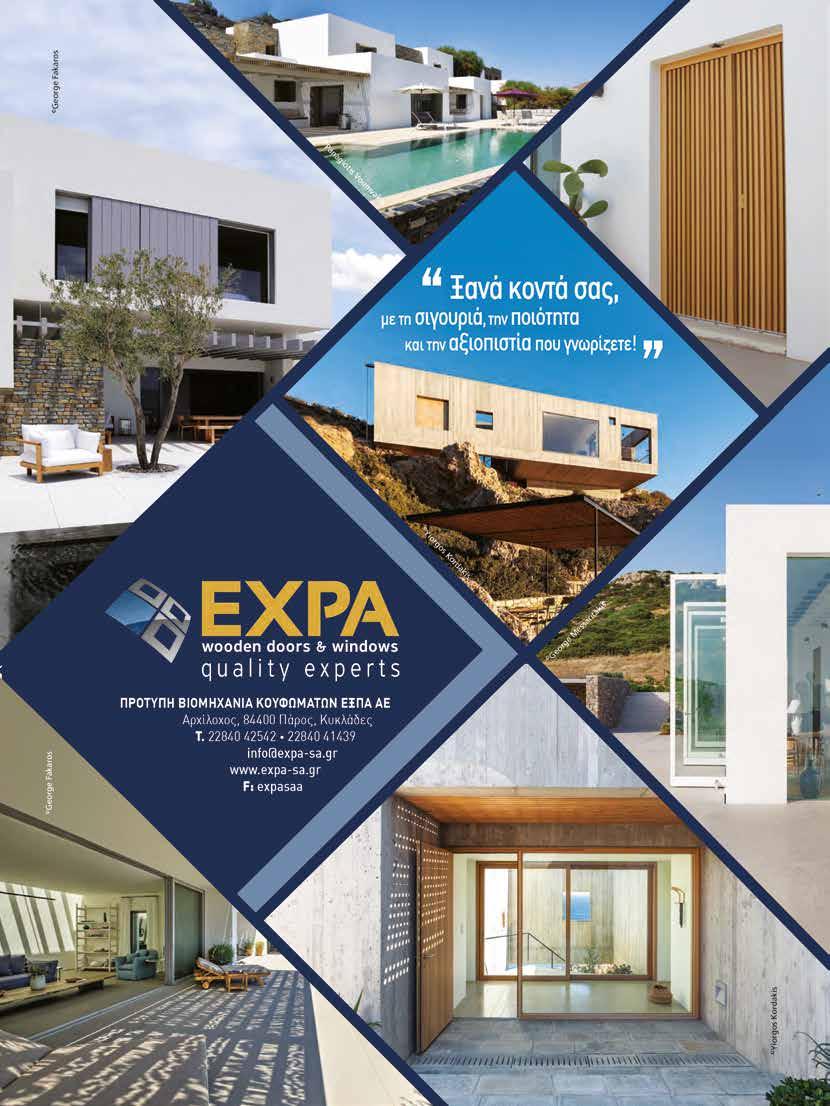
JUNE - JULY 2025

offer visitors a glimpse into the island’s past through the lens of a world-renowned Greek photographer.
Opening hours: Daily from 10:00 to 20:00, free admission. Head of Santorini Photography Team: Kostas Theodoropoulos. Contact: santophotogroup@gmail.com
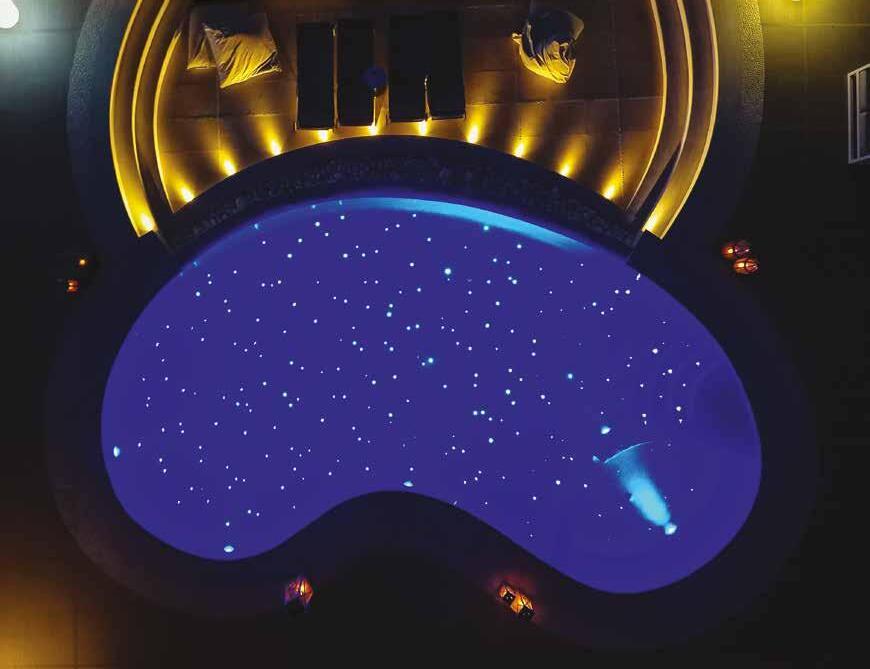
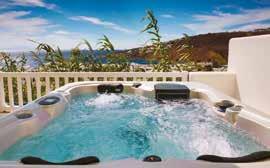


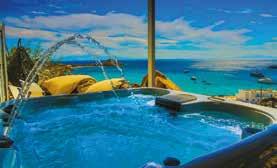
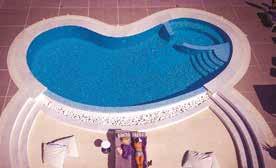

WE ASSOCIATE IT WITH ITS RELIGIOUS CHARACTER, BUT THE ISLAND HAS SO MANY DIFFERENT AND EQUALLY FASCINATING SIDES THAT ARE WORTH DISCOVERING.
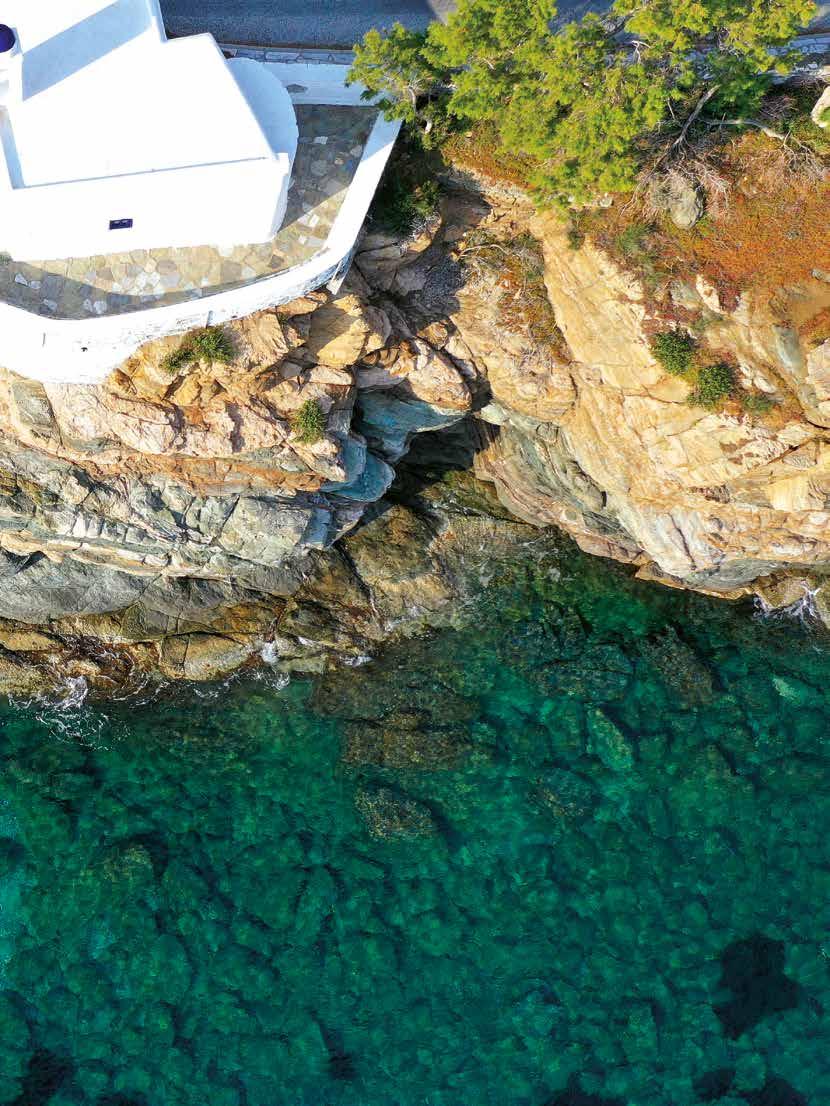
H
ΒY MARIA ATMATZIDOU
Τhe traditional settlements of the hinterland, the inexhaustible beauty of the coastline, the untouched natural landscape, the masterpieces of fine art, architecture and marble art, the impressive geological formations and the imaginative gastronomic delights, combined with an authentic aura that emanates from every inch of the Tinian land, make up a unique Cycladic island. Well worth exploring with an open mind and heart!
The cool sea breeze gently caressed my face as we began our trek inland. The aim was to visit as many villages as possible -like little children counting ice creams or summer dives to compete with their friends. You see, Tinos has some precious treasures that it has kept untouched over time: its 52 traditional settlements. On hills, slopes or fertile plains, with churches, arched alleyways, flowery courtyards and welcoming squares, the picturesque villages are full of life. First stop, Marmarochoria in Exo Meria (Outer Side), as the locals call it. And especially in the “open-air museum of marble crafts”, Pyrgos. Walking through the marbled streets, we admire the marble details that decorate the lintels and door frames of the houses with their simple elegance, the inscriptions and coats of arms, and the fountains that cool us with running water -a settlement like a living postcard. In the well-preserved house-museum where the sculptor Yannoulis Chalepas lived, we admire some of his important sculptures and travel back in time. The creative expressiveness of Tinian’s sculptures can be seen in the Museum of Tinian Artists, in the churches, even in the cemetery, as well as in the charming shops with souvenir sculptures by contemporary artists. Sitting at colourful tables under the heavy shade of the huge plane tree in the middle of the central square, we enjoy the cool water of the impressive marble fountain, a syrupy galaktoboureko and a glass of homemade
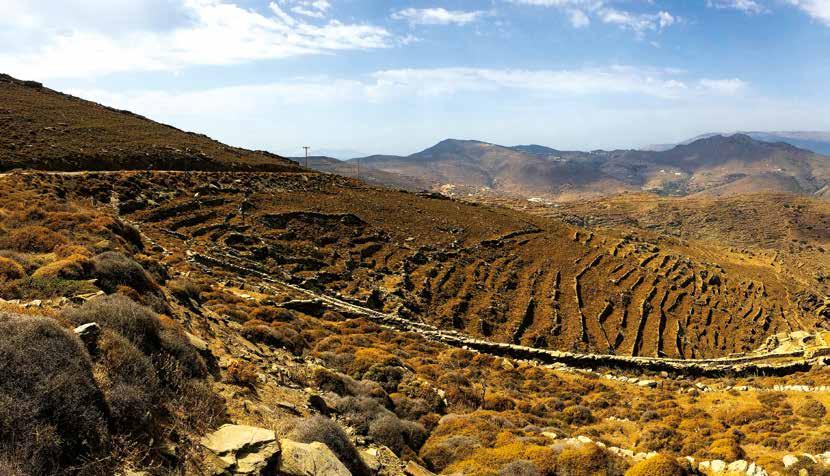
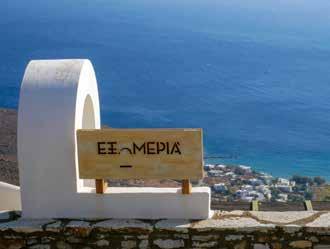
lemonade -the best reward after exploring the cobbled streets. Just outside Pyrgos, we visit the Museum of Marble Crafts to learn about marble technology and the secrets of Tinian’s marble craftsmanship, which has been recognised by UNESCO as part of the Intangible Cultural Heritage of Humanity. We go to the Mali-Koumela quarries, in the northwest of the island, to get a taste of the famous green marble, but also to go down the steep path (in many places a dirt road) to the tiny beach of Koumela. A dive in the crystal clear waters of this rocky bay, with its few tamarisk trees and even fewer houses, is the best way to escape from the booming reality.
Back uphill to the main road, we head northeast of the island to the coastal village of Panormos, which played a very important role in the development of trade by transporting Tinian marble to the far reaches of the world. In the picturesque natural harbour, with fishing boats bobbing in the crystal clear waters and the rocky islet of Planitis with its ruined lighthouse, we dine on steaming fish delicacies (I first tasted stingray here years ago), freshly grilled fish and salads from the island’s gardens.
Now it is the turn of the other marble villages, Ysternia and Kardiani. Built in an amphitheatre style, both have uninterrupted views of the vast Aegean Sea -and a spectacular sunset. Many times in Ysternia

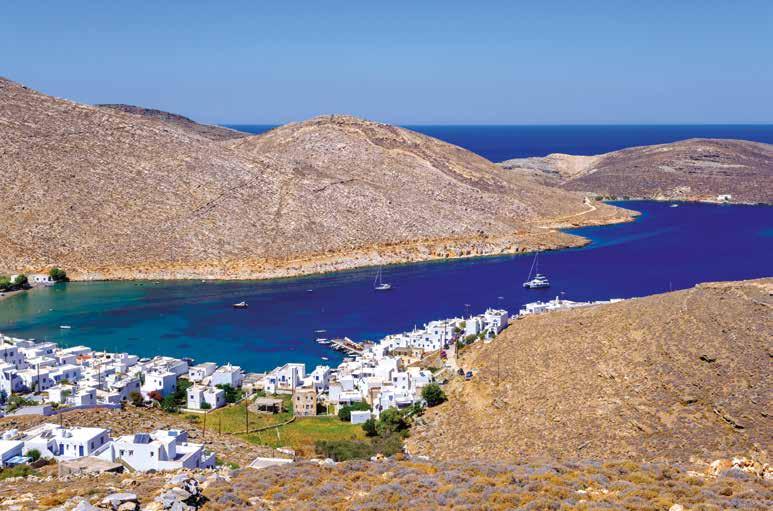
I have enjoyed a refreshing drink while the sun, like a huge ball of fire, painted the whole creation with fire. Marble is ubiquitous here, too. The Byzantine church of Agia Paraskevi, the busts and statues in the alleys and the central square with its shady plane tree, and of course the Ysternia Artists Museum. Other times, we have headed to the bay of Ysternia for a quick swim in the small coves and then a delicious lunch at the seaside taverna. But now we’re off to Kardiani, which has a special place in my heart. Green and white at the same time, with the houses looking out at the sunlight playing with the waves. We walk along the cobbled streets and under the arcades and arches to rest in the sunshine and say hello to the villagers. We visit the churches, both Orthodox and Catholic, cool ourselves in the springs that gurgle incessantly, and rest in the square where the plane trees generously give us their shade -for me the best local fairs I have ever experienced were here. Easter and summer, islanders and visitors meet and dance, all in one embrace, until dawn.
The people of Tinos divide their island in a strange way. Kato Meria (bottom side), on the north -Pano Meria (upper side), on the south! For us, of course, it doesn’t matter. All the villages are beautiful, wherever they are. And they are unique, as are the 961 counted dovecotes, ornate works of art that stand proudly like little castles, basking on the slopes, valleys and gullies, places open to the birds -“good flying”, according to the locals. The island used to export squab meat all over the world, as it was a sought-after delicacy due to its nutritional value. With the oldest dating back to around 1700, dovecotes were a symbol
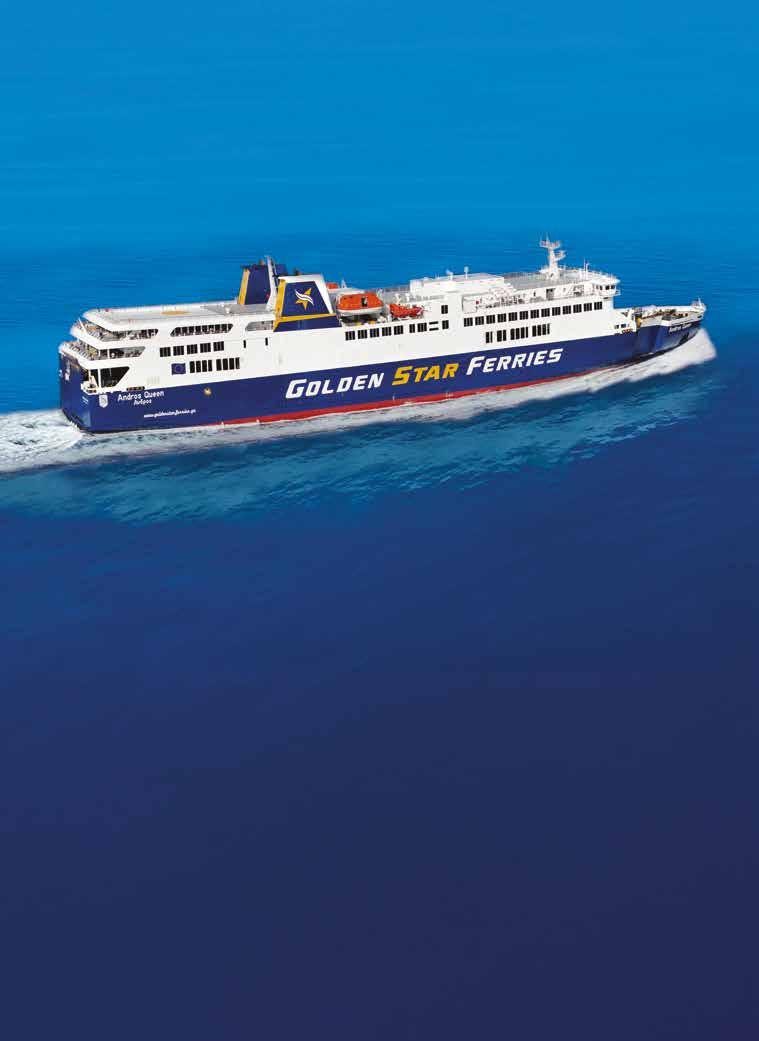


of social status and economic prosperity.
In Tarampados, our gaze sweeps across a vast valley dotted with some of the oldest dovecotes on the island. In Kampos, the fertile heart of the island, we stroll through the village with its two churches, Agia Triada and Agia Ekaterini (Catholic and Orthodox respectively), taste delicious local products (if you’re here on 15 September, don’t miss the honey festival!) and visit the museum of artist Kostas Tsoklis. We pass through Kalloni with the monastery of Agia Ypakoe and the basilica of Agios Zacharias with its beautiful pebbled courtyard.
Later, we climb up and down the steps and through the labyrinthine alleys of the picturesque settlement of Agapi, which spreads over the entire slope. Like a theatrical performance, we watch the spectacle of the “playful” dovecotes scattered along the village stream as they are bathed in the afternoon light. In Komi, again in its hospitable, lively square, we enjoyed not only wonderful desserts and wellmade cocktails, but also the famous Tinos artichoke in the famous fourtalia, the delicious and hearty omelette -it is worth attending the Artichoke Festival at the beginning of May, not only for the well-cooked
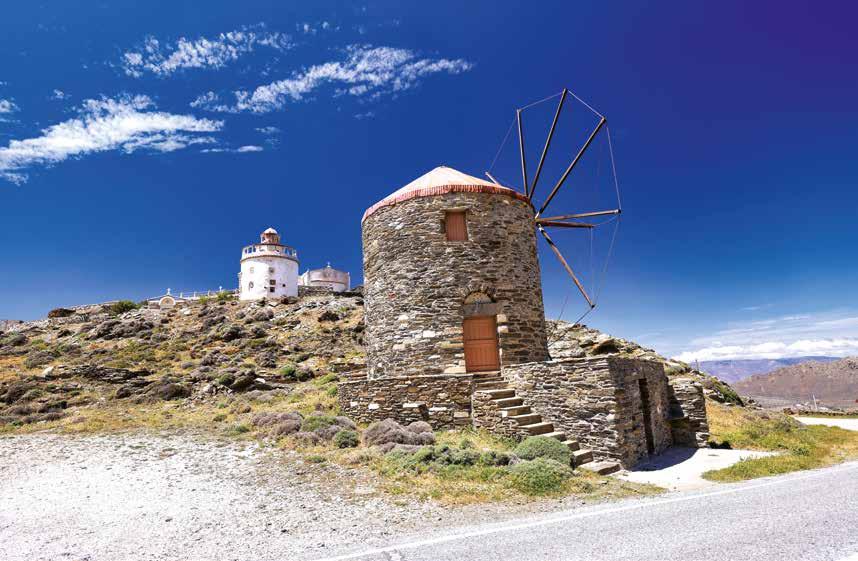
Επόμενος προορισμός μας ο Βράχος του Εξωμβούργου, το Ξώμπουργκο όπως το λένε οι ντόπιοι. Ο επιβλητικός
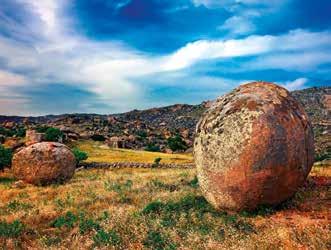
delicacies, but also for the dances accompanied by violins. In Loutra, a visit to the Ursuline Monastery (founded in 1862), now a folklore museum, as well as the Jesuit Monastery is a must.
Our next destination is the Rock of Exomvourgo, Xombourgo as the locals call it. The imposing geological formation, which reaches a height of 640m, has been inhabited since the Bronze Age when the Cyclopean Wall was built. The fortress was built during the Venetian occupation and was named “Castle of Agia Eleni” -from the top the view is unique. Along the way we meet hikers and climbers who are after the adventurous aspect of the rock. On the island there are many signposted paths that cross the mainland to the most inaccessible beaches and are ideal for organised hikes -with a stunning finale at Plati, a beautiful ravine with 150-200 year old plane trees.
But Volakas is also beautiful. What can be said about the huge granite boulders scattered across the otherworldly landscape, bearing resemblance to mythical Titans and Giants? In the picturesque settlement, we wander along the cobbled streets, among neat courtyards and whitewashed houses with blue doors and windows,
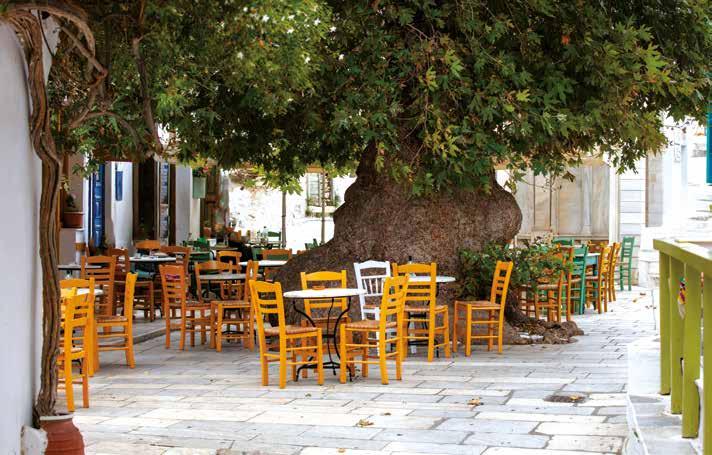
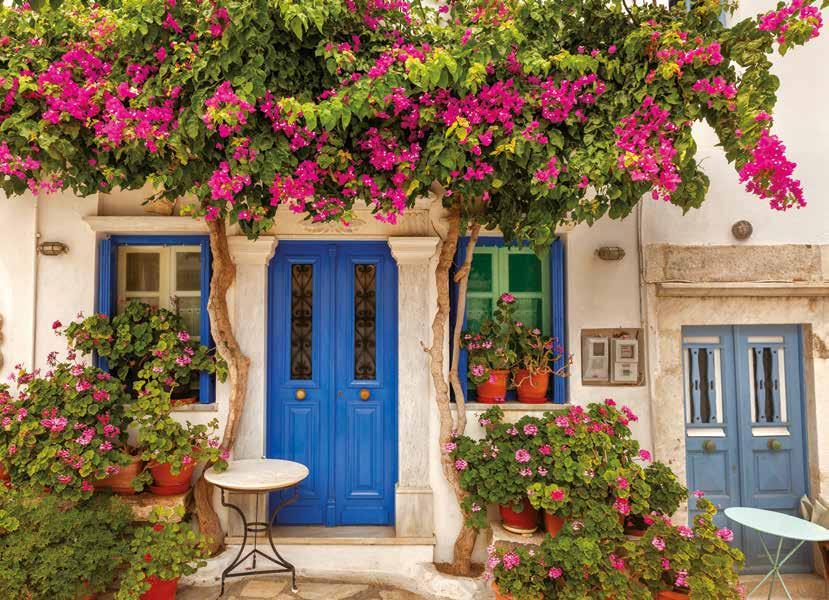
marble fountains and lintels, but also aesthetic interventions that will surprise you. A white-painted bicycle and a pair of all-white shoes are transformed into pots of geraniums. Verses from poems and songs are written on the walls and doors of the houses. Elaborate baskets adorn the doors, remnants of the ancient art of basketry. And a small openair theatre made of stone and marble emerges from the rocks. What a creative fervour infuses the whole place!
A morning swim at cosmopolitan Agios Fokas, a Blue Flag beach just a 5 minute drive from Chora, is a great way to start the day. We are now heading to Dio Choria, another favourite settlement. We climb the steps to the welcoming square with its tall plane trees and stroll among the whitewashed houses that reflect the love and care of their inhabitants. Next up is a good traditional breakfast to give us energy for the journey, along with some louza (traditional sausage) and Tinos cheese (volaki) or Tinian graviera for added flavour. And a sweet cheese pie, the famous “tsimpiti” with the pleated folds -a delicious treat from the housewives of Tinos- that melts in your mouth with its fluffy flavour.
We continue to Arnados and the Monastery of Kechrovouni. We drink our coffee in the square and enjoy the authenticity of the Tinian settlements, which have kept their traditional colour untouched. In Falatado, one of the oldest villages, we sample the local raki -or rakomelo, which is my favourite. It is no coincidence that “Rakizio”, the festival of raki, is held here on 8 September. We continue towards Steni and from here we start the route to the protected beach of Livada (NATURA 2000). The last 4km
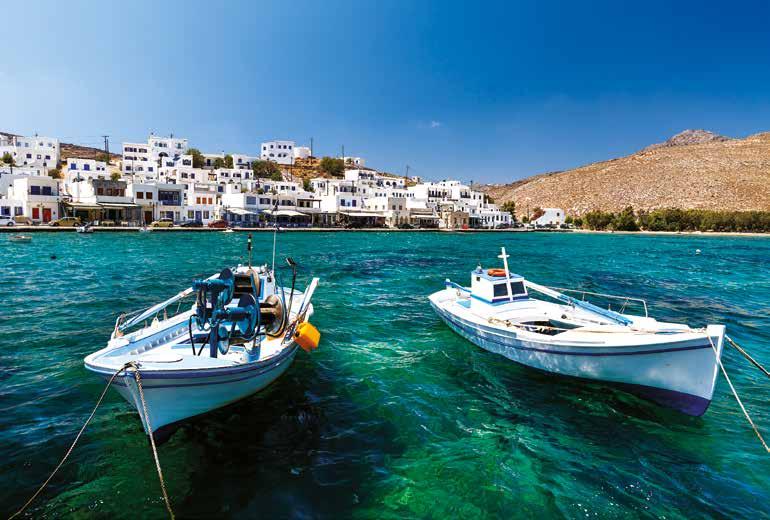
is a dirt road, but the wild beauty of the scenery makes up for it. Flowing streams that end in the sea, a small pond with ducks, geese, swans and turtles, rocks sculpted by the wind and deep blue, often turbulent waters (so be careful when swimming, especially when the wind blows from the north).

We continue our hike to the highest mountain of Tinos, the Tsiknias (714m). The landscape is impressive, with rock formations that are steep and windswept. Here, according to ancient sources, the worshipers came to the sanctuary of Aeolus, the god of the winds -the name Tsiknias [The smoky one] may derive from the animals sacrificed to the god. Goats pop up from the low bushes, while down by the sea the Livada or Papargyras lighthouse stands lonely and proud on the greyish rock. The view to Delos and Mykonos is impressive. On our way back, we decide to admire the sunset first. We head for Kionia, next to the ancient temples of Poseidon and Amphitrite, but also to the pebble beach of Agios Markos, with its calm waters, which can be reached by descending the steps from the homonymous white chapel. Just a breath away from Chora, it is the ideal place to swim in an incredible palette of colours that only nature knows how to create. Tinos, at its best!
Iφιγένεια Τζόλα Ifigeneia Tzola
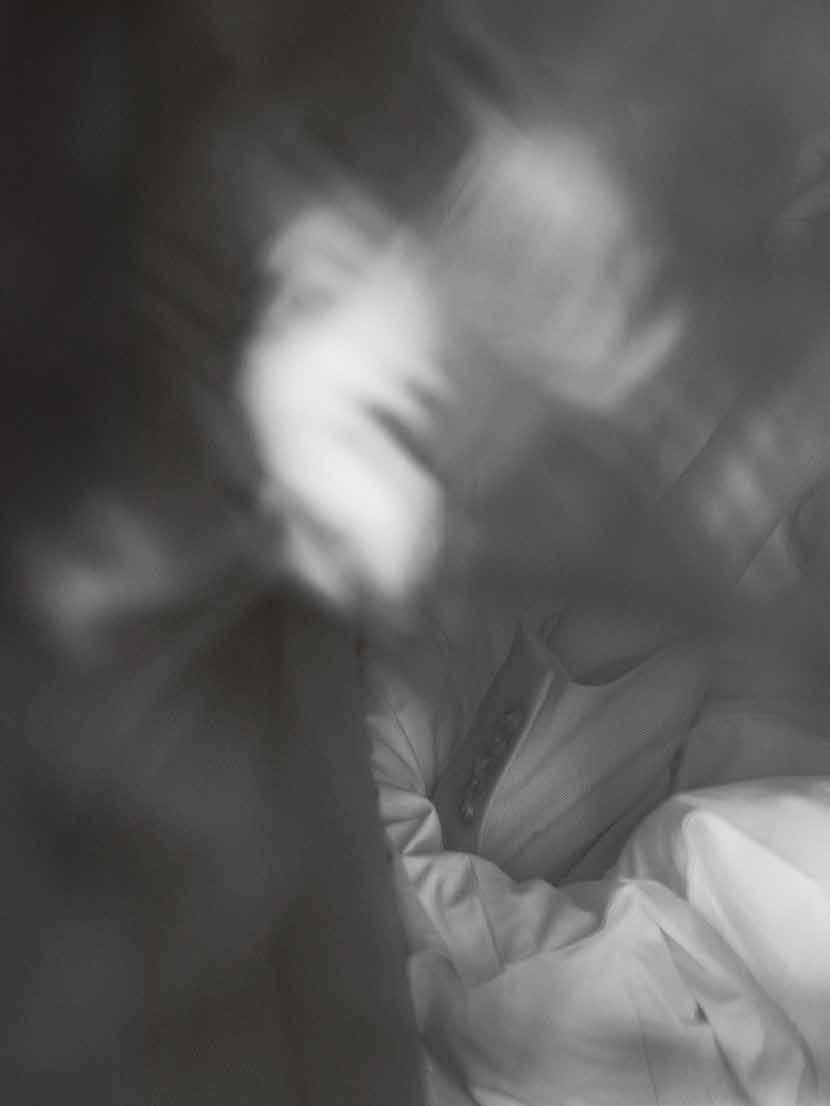
«Ζω
“I live my own fairy tale”
WE MET THE ACTRESS STEPPING INTO THE DEEP EARLY ON IN THE SERIES “THE ISLAND” AND SHE HAS BEEN MEETING THE DEMANDS OF ACTING MORE AND MORE SUCCESSFULLY EVERY YEAR SINCE THEN.
ΒY MIA KOLLIA, PHOTOS: ANDREAS SIMOPOULOS
STYLING: SOPHIA TSAKIRI, MAKEUP-HAIR: MORFE
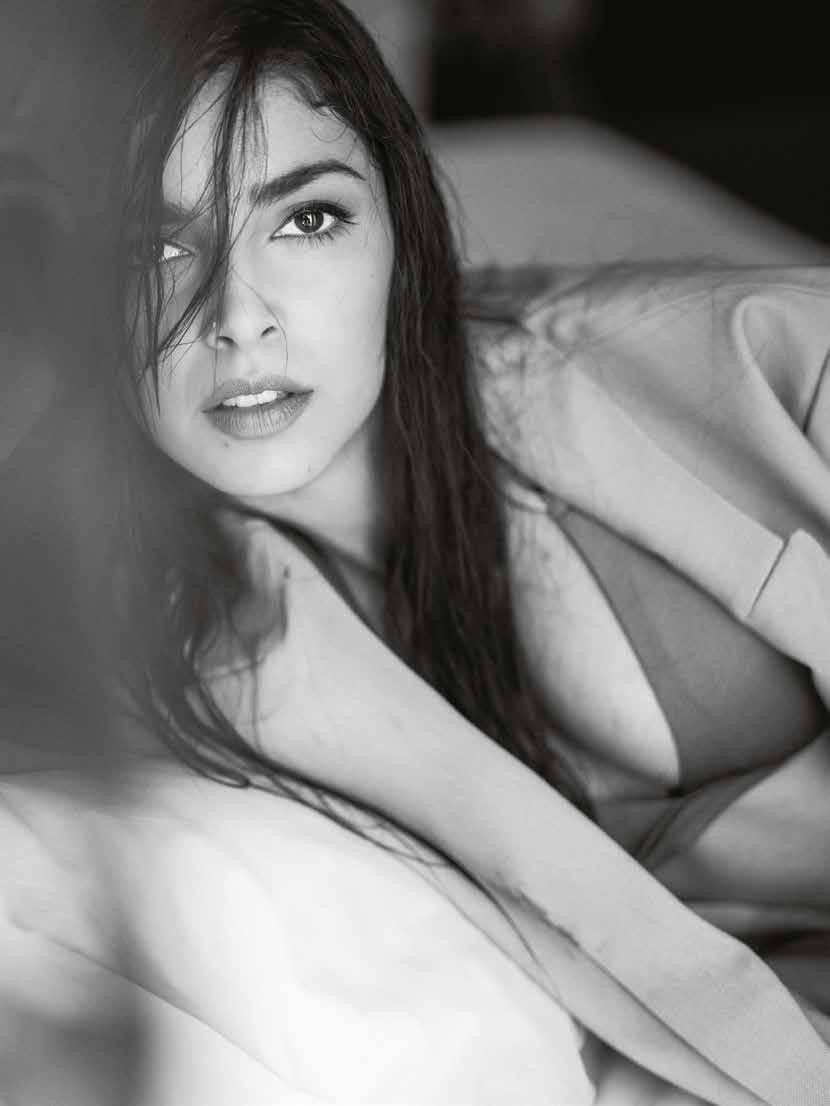
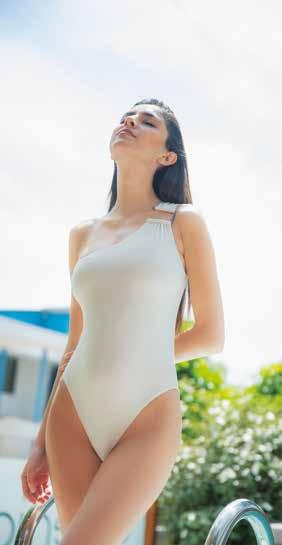
Tver the past few TV series, we have been following her on the popular drama “I gi tis elias” (Land of the Olive). She seems sweet and nice, and she is also kind and modest. A girl who started this demanding career at a very young age, playing our national star at the tender age of eight, has had to learn to defend herself against the constant glare of the spotlight. She has done so with dignity and discretion. An excellent student with an aptitude for theoretical sciences, she began studying International Relations at the same time as taking the Ministry exams to enter the “Iasmos” drama school. Since then, she has never stopped working, trying and learning.
Did you grow up in a family connected to the arts? And how exactly did “The Island” come about?
No. My family had no connection to acting or this field in general. The “Island” was my second piece of television work and I would say it was also the result of other circumstances. My first TV job was in the series “Eho ena mystiko” (I have a secret) as Aliki Vougiouklaki, at the age of 8. After my participation in this series, the “Matharikou” agency sent my sister to the audition for “The Island”. It took place at the home of screenwriter Mirella Papaeconomou, who recognised me and gave me a few lines to audition with. That’s how I got the chance to take part in this series.
What do you remember about this experience? I mean, what are the conditions like for a young child? What does it have to offer and what complicates things?
I remember that for me, the whole experience of both “The Island” and “I Have a Secret” was a beautiful journey. I couldn’t wait to be on set, go to work and do what I had to do. I only got positive things out of it. From a young age, I was taught to respect my colleagues and work well in a team. I learnt to be disciplined, to be aware of all aspects of the work and to understand the importance of trying hard to achieve a good result. I would say that this experience has made me more mature. But, apart from what I personally gained, I also developed important skills for my work.
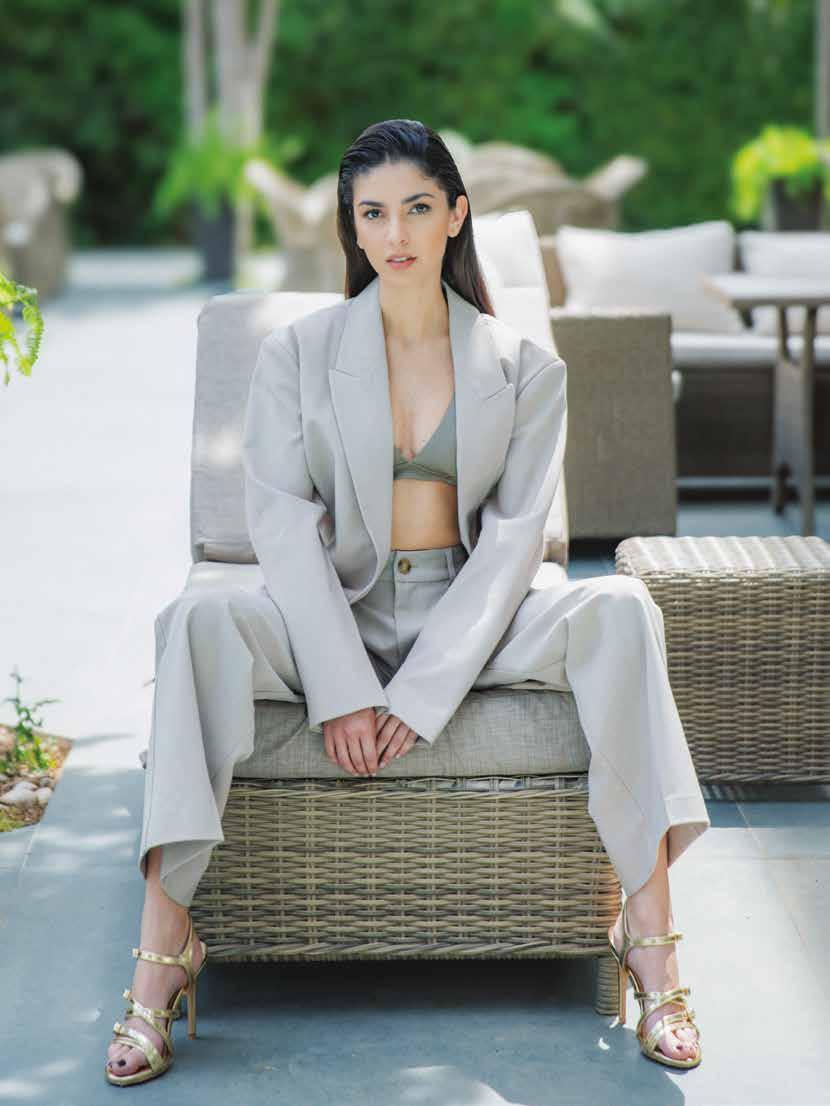
I wouldn’t trade Greece for anything. I may live in Greece, but every place I have visited has been a dream for me H

I have worked with esteemed colleagues who have provided guidance and advice at every turn. It was a school for me, and I’m grateful to have experienced it.
How much do luck matter? How much do willpower and passion matter? And how much do studies matter?
Luck, willpower, passion and hard work are all factors that come together to create a specific career path. I would never evaluate each one separately, such as luck. For example, I would never say that I will not achieve what I want without luck. I’m someone who doesn’t like to leave things to chance. When I want something badly enough, I persist until I achieve it. Willpower is very important, but here I would also like to mention awareness, which I believe is intertwined with willpower and necessary for moving forward. You need to know what you want and why you want it. In short, you need to be goal-oriented. If you have the abovepoints covered, then you will have the passion to do it and not merely the enthusiasm that many people confuse with it. Finally, I believe that studies are necessary. It is the tool that will

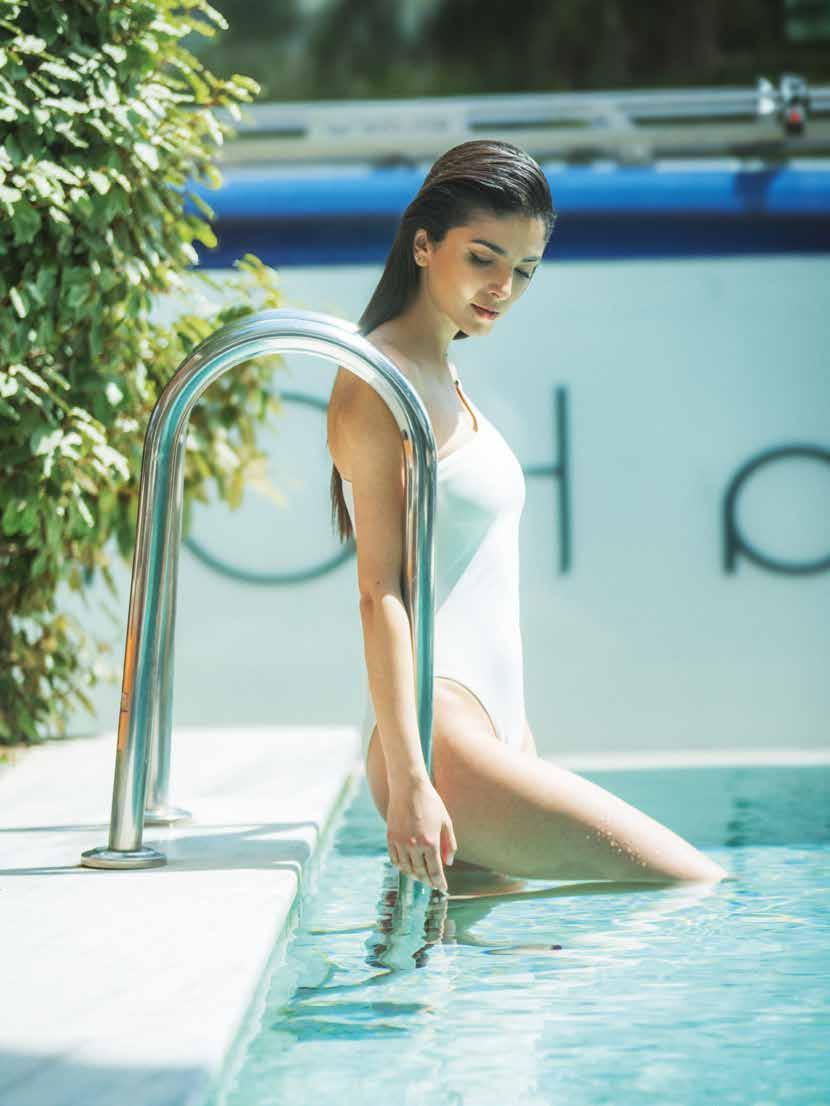

allow one’s talent to be developed appropriately. It is the foundation on which further development will be built.
Which characteristics do you think are important for a director?
To remain calm in order to convey a sense of security to the actor and elicit from them what they have envisioned. To be able to discuss any questions or opinions regarding the scenes. Not to put you in a “mold” as we call it in acting. I also believe that inspiring confidence is very important.
What role does art play in your life, in general? Do you like watching films? Do you attend exhibitions, museums or concerts?
Art is creation and a form of expression. I remember going to theatre and ballet performances, the cinema and museums as a child. Art is everywhere in our lives. It can reveal things about our past, raise concerns, entertain us. To me, nothing in the world would be the same if there were no art in its various forms. Even people themselves would not have evolved into the beings they are today without art. It shapes the anxieties and sorrows of our soul.
What are your favourite travel destinations?
Every trip I took was beautiful and special because, apart from the destination itself, the company I kept and the experiences I had were unforgettable.

If we’re talking about Europe, I’d say I have a particular fondness for Italy, and specifically Rome. Apart from being an incredibly picturesque and beautiful destination, Rome is an important milestone in my artistic career because it was there that I won my first two awards for participating in the Polish film “Usmiech losu”. I think the trips I have taken outside of Europe are like something from a fairy tale and completely unique, so it would be unfair to single any of them out. But, ultimately, I wouldn’t trade Greece for anything. I may live in Greece, but every place I have visited has been a dream for me.
What are your plans for the near future?
I am performing in “Notre Dame de Paris”, directed by Reina Eskenazy and featuring music by Stamatis Kraounakis. I am playing the part of Esmeralda. In this production, I am performing alongside Konstantinos Kazakos, Orfeas Papadopoulos, Eleftheria Rigou, Giorgos Papas and Thanos Tzovikos. I’m really excited about this production, it’s one of my favourite stories by Victor Hugo, and it’s a play that people of all ages will enjoy.
How much like a fairy tale can our lives be? Have you lived your own fairy tale yet?
Everyone’s life should feature a fairy tale. We write our own stories and chart our own courses through life and should always try to shape our circumstances so that we can be happy. The concept of the fairy tale hinges on the idea that everyone is capable of finding happiness, that is fulfilment. Bearing this in mind, it becomes easier to achieve our own fairy tale. I live my own fairy tale. Whatever the circumstances that shape my daily life in the future, I will always strive for such happiness.
Would you say you are an optimist?
I am a very optimistic person and almost always have positive energy. I think this stems from the fact that I am happy. I have a job that I love and that fulfils me. I have encountered difficulties and obstacles that have upset me, but not to the point of losing my optimism. I try to overcome whatever is holding me back and move forward.
We would like to thank the Athenian Riviera Hotel & Suites (7 Danae & Harmony Streets, Vouliagmeni, www.arhotel.gr) for their hospitality.

Ομελέτα

WITH FRESH EGGS AND QUALITY LOCAL INGREDIENTS, THE FAMOUS OMELETTES ARE TRANSFORMED INTO THE MOST NUTRITIOUS -AND DELICIOUS- DISH AFTER A SUMMER DIVE IN THE CYCLADES.

Perhaps the simplest, most satisfying, delicious, quick, versatile and soul-soothing food –a true comfort food. International and local alike. Breakfast, lunch for energy or a light dinner. The omelette was, is and always will be the ultimate passepartout and... the canvas for the most creative imagination. Just take a look at the incredible gastronomic range of the Cycladic islands, with their impressive or even strange names. Eggs from local chickens, beaten with a fork into the nutritious batter everyone knows and loves, are mixed with local potatoes, collards, squash blossoms, wild artichokes and courgettes, broad beans and wild mushrooms. Along with the traditional sausages or cured meats of the islands, but also local cheeses, more or less strong. They are fried in hot oil or baked in the oven and served hot with a simple fresh salad and some kneaded bread. What more could you ask for?
Froutalia
The island that is perfectly associated with the omelette is definitely Andros. The second largest island of the Cyclades, with its flowing waters and rich biodiversity, is one of the most fertile Cycladic islands. That’s why it provides all the ingredients needed to make one of the most delicious traditional omelettes -the froutalia of Andros. Fresh eggs, in generous quantities (up to twelve), are beaten with milk and simmered in salted pork fat, along with delicious local



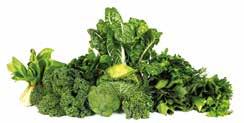
sausages, dry volaki cheese from Andros, and sliced potatoes. The dish is sprinkled with herbs such as oregano, marjoram, parsley and spearmint to bring out the aromas of Andros. Depending on the season, they add onions, courgettes, chard or asparagus, which makes the hearty omelette even more colourful and flavourful. In Tinos, it is also known as fourtalia. There, they also add the famous Tinian artichokes (grown in Livadi, Komi and Kalloni), louza and Tinian cheeses. Once browned on one side, the skilful island cooks “tumble” it into the pan to cook the other side, before serving it up -a real temptation! You can also taste traditional froutalia, which is thick and delicious, in Mykonos. It is made with similar local products, such as the characteristic kopanisti cheese, and vegetables straight from the island’s gardens, which guarantee a delicious result. After all, each local froutalia gets its unique character from the salted pork and sausages, which are prepared with great care by the islanders using a variety of aromatic herbs.
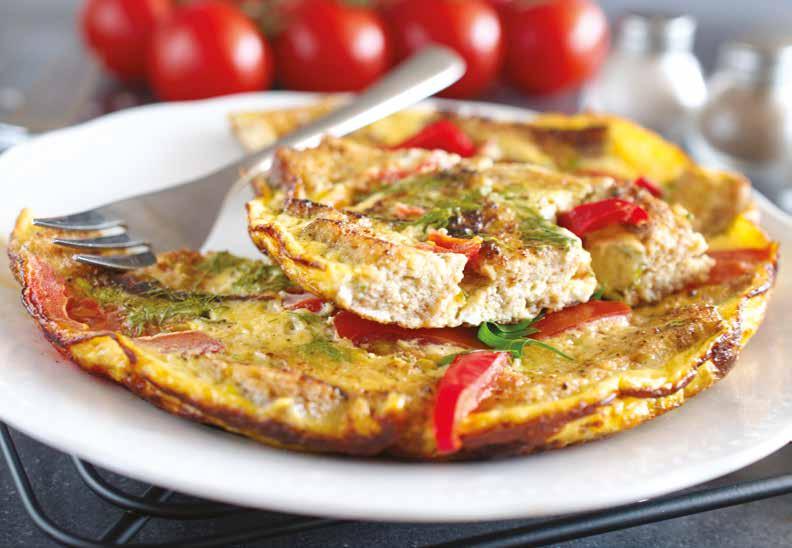
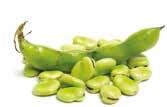

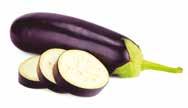

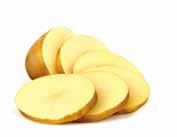
Koskosela
Lightly scrambled eggs are poured into a pan containing bright red, fragrant Santorini cherry tomatoes and luscious white aubergines -a trademark of the island of Santorini. The mixture is then simmered in the pan until all the liquid has been absorbed. The rosy red omelette is filled with fragrant onions, delicious kefalotyri, salt, pepper and a little oregano. And behold the “koskosela” or “korkosela”, the omelette which, in other regions, is also known as “strapatsada” (from the Italian verb strapazzare, meaning “to scramble eggs”). In Santorini, it is also known as “kampouna”, thanks to the onion flowers that were traditionally used in local recipes. This hearty and aromatic omelette can also be found on other Cycladic islands, with variations and local touches such as in Naxos, where it is served with freshly fried potatoes (famous in Naxos); in Milos, where they add touloumotyri or skotyri cheese; and in Syros, where they add crispy courgettes and the famous San Michali cheese, so it is also

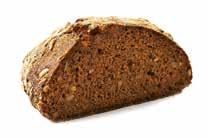
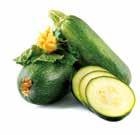

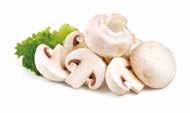
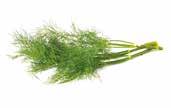
known as a courgette omelette or by the cheerful name... “tirititim”. But also on Tinos and Mykonos, as well as on Kythnos, where they add courgettes to the thermiotiki strapatsada along with trimma cheese and fresh tomatoes.

It could be a fluffy courgette pie. Or a Cycladic souffle without bread and pasta. Or an omelette that’s completely different from the others. Santorini’s sfougato is exactly that: a little bit of everything. A mishmash of freshly beaten eggs, with grated courgettes, sautéed spring onions and local grated cheeses, flavoured with spearmint, dill or fennel, which all come out of the oven puffed up and rosy red; it’s finger licking good. Santorini, at
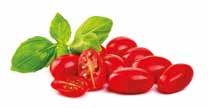


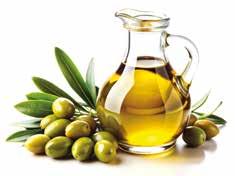
its most delicious! In Folegandros, on the other hand, the famous avgolalia -eggs beaten with goat’s milk and fried in hot oil- is something between an omelette and a pie.
Also delicious is the omelette with tender courgettes and local fine capers, the famous kolokithokapari of Kimolos, as well as the bouleri eggs, cooked with potatoes, grated tomatoes and chopped onion, seasoned with cinnamon, salt and pepper.

The omelette with pork kavurma from Amorgos brings with it the aromas of oregano, bay leaf and a touch of allspice. What is certain is that whichever one we try, it will be stealing our hearts! Because the omelette on the islands has something of the Cycladic aura that we find hard to part with -and we always crave it.


PHOTOS: DIMITRIS FOUTRIS© GAÏTIS - SIMOSSI MUSEUM, ALL RIGHTS RESERVED
IOS HAS ACQUIRED A NEW ATTRACTION: A STUNNING MUSEUM CELEBRATING THE WORK OF TWO GREAT ARTISTS AGAINST THE BACKDROP OF THE ENDLESS BLUE SEA.

TΕπάνω:
Above:
The characteristic Gaïtis Building.
Right: View of the artist’s work.
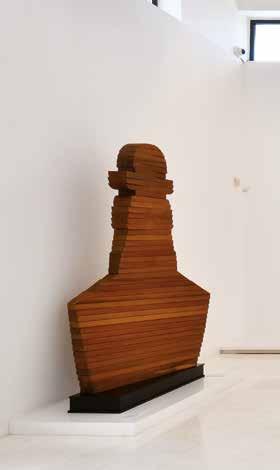
The Gaïtis-Simossi Museum, dedicated to the work of the painter Yannis Gaïtis and his wife, the sculptor Gabriella Simossi, was established in partnership between the Municipality of Ios and Loretta Gaïtis, the two artists’ sole heir and intellectual beneficiary. It is housed in a 1,600 sq. m. building complex of unique architecture, designed by Loretta Gaïtis and Jacques Charrat to host the two artists’ permanent exhibition, as well as temporary exhibitions and events. Built on top of a hill, it boasts panoramic views of Chora, the port of Ios, and the islands of Sikinos, Paros, and Naxos. On a clear day, you can also see Milos and Sifnos against the backdrop of the endless blue of the Aegean Sea.
The Gaïtis-Simossi Museum’s main objective is to promote and highlight the work of the two artists, both nationally and internationally. Moreover, the museum seeks to be a living core of culture and creativity by offering a rich range of activities and experiences, such as temporary exhibitions, cultural events and educational programmes.
The museum was ceremonially opened on 14 September 2024 by former President Katerina Sakellaropoulou, with Minister of culture Lina Mendoni in attendance.
The permanent collection is housed in two main buildings: the Gaïtis Building and the Simossi Building. A series of oversized heads of the characteristic “little men” (anthropakia) of Gaïtis invite the visitor to the museum. The Gaïtis Building’s architecture is inspired by the “little men”: the roof’s curvature is based on the design of their hats and the entrance door is
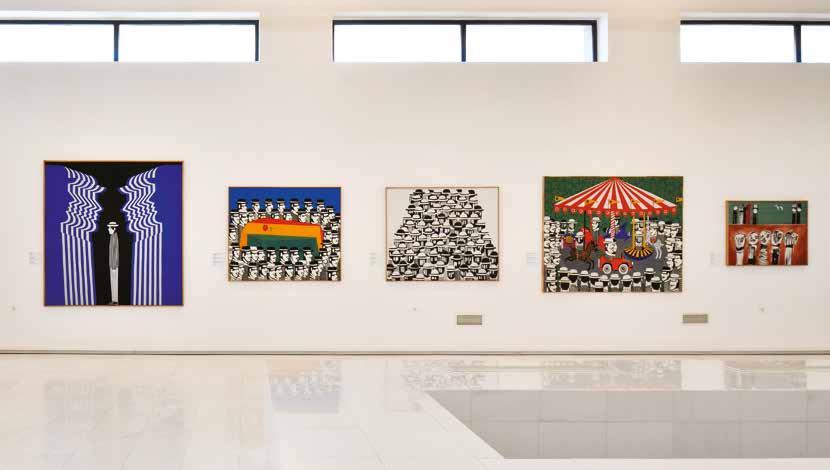

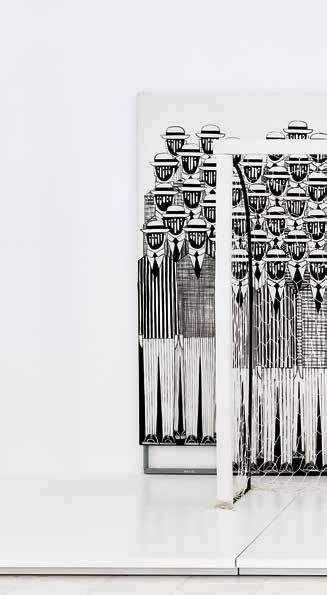
Αριστερά: Η Λορέττα Γαΐτη, κόρη των δύο καλλιτεχνών. Δεξιά: Γιάννης Γαΐτης, «Ολυμπιακός-Παναθηναΐκός: Το τέρμα». Κάτω: Έργο με τα χαρακτηριστικά «ανθρωπάκια» του Γαΐτη. H
Left: Loretta Gaïtis, daughter of the two artists.
Right: Yannis Gaïtis, “OlympiacosPanathinaikos: The goal”. Below: A work with the characteristic “little men” (anthropakia) of Gaïtis.

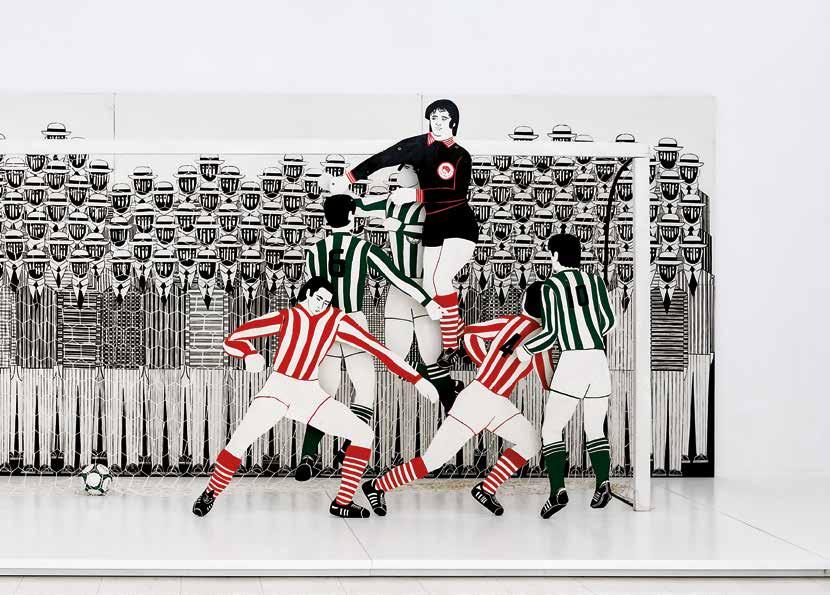
based on the design of a head viewed from the front. The Gaïtis Building extends over two floors, with the museum’s reception area on the ground floor. Upon exiting, the visitor discovers an elevated courtyard with an olive tree, from where they can access the Simossi Building.
As is obvious, Gabriella Simossi loved white: the sculptures are white, the walls are whitewashed and the floor and pedestals are covered in white marble. A series of arches provides successive views of the impressive sculptures on display in the centre of the exhibition space.
Gaïtis’s collection is arranged chronologically, starting on the ground floor, with his earliest works from 1948 to 1963, and moving up to the first floor, which is dedicated to paintings, installations and constructions featuring the famous “little men”. The works on display span the period from 1964 to 1984, the year of the artist’s death.
Simossi’s exhibition features ten monumental white resin sculptures created between 1970 and 1983, which were enlarged in 1999, the year of her death. Also on display are plaster sculptures from the period 1962-1969, while the collection is completed by around forty original photographic collages from the mid-1970s.
Loretta Gaïtis explains: “Yannis and Gabriella both hail from the Aegean: my father is from Tinos, a fertile land that has produced many artists; my

mother is from Milos and Euboea. However, when it came to choosing the resting place of my father, who died at the young age of 61, I chose Ios. I built here a small white chapel near his house, where they both rest today.
”Yannis Gaïtis, from Athens, discovered Ios during a trip with his friend Jean-Marie Drot. They both loved the island and decided to make a pact with it, putting down roots in its rocky soil. Shortly afterwards, in 1964, Gaïtis designed and supervised the construction of Jean-Marie Drot’s house on Ios. Meanwhile, Gabriella Simossi created imposing sculptures inside the house and on the terraces overlooking the sea.
”A few years later, Yannis Gaïtis started the construction of his own house, on the other side of the same small bay. The two houses still stand facing each other today, symbolising an eternal coexistence in this remarkable space.
”Yannis built his house patiently for almost ten years, a work of happiness and freedom. He worked on his paintings there until his death on 22 July 1984, just a few days after the opening of his major retrospective exhibition at the National Gallery of Athens. Then Minister of Culture Melina Mercouri honoured him as citizens in ancient Greece were honoured for glorifying their city.
”Keeping my parents’ work alive was imperative to me, and Ios was the obvious and loyal choice. In 1997, my partner Jacques Charrat and I started the first sketches for the architectural design of the museum. I was delighted that my mother was able to see the model of the future museum before she died, on 27 May 1999; just before the opening of her retrospective exhibition in Paris, at the Couvent des Cordeliers.
”Thanks to the steadfast support of the Municipality of Ios at every turn and the invaluable assistance of the Ministry of Culture, this profound dream of mine was realised when the construction of the museum was completed in 2009. We started with Georgios Poussaios, the then mayor, and then with Michalis Petropoulos. Finally, Gkikas Gkikas made the completion possible through his continuous efforts.
”Without a doubt, my beloved parents, Gaïtis and Simossi, taught me that it was necessary to repeat the same gestures every day, tirelessly and
Αριστερά:
1974.

Left:
Gabriella Simossi, “Hermès”, 1974.
Right: View of the installation in the Simossi Building.
Below: View of the work of Yannis Gaïtis.
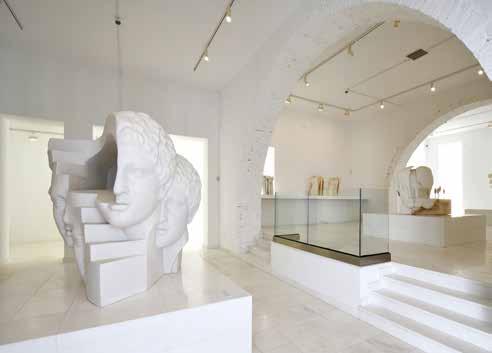

with determination, sometimes to the point of exhaustion, in the service of a project and a noble cause. They showed me that this is ultimately the only way to live.
”All these gestures, this convergence of energy and goodwill, mark the beginning of this museum. I hope it will lead to the inclusion of Gaïtis and Simossi in the national heritage of the Greek people, and allow art lovers to better understand the diversity, richness and modernity of their work”.
Gabriella Simossi was a renowned sculptor who embraced contemporary trends. She met Yannis Gaïtis at the School of Fine Arts in 1945, after which they embarked on a shared path to Paris. Her anthropomorphic figures, which have an experiential and autobiographical quality, are fragmented, mutilated and silent, as if to convey the idea that reality does not permit classical perfection. The white colour of her sculptures reinforces the sense of imperfection, alienation and lack of communication, which is slightly softened by the humour with which she approached her subject.
Yannis Gaïtis was one of the pioneers of post-war modernism. A proponent of the new European trends of the time, he left his mark on Greek art through his unique artistic idiom. The main feature of his artistic production are his “little men”, which to this day are a symbol of massification, posing key questions about political and social issues. “I have painted about four and a half thousand works. […] Today I am making the little man, I don’t have the power to change it, because the little man represents me perfectly [...] but people don’t want to see themselves as little men [...] Because they say, “that’s not me”. And yet they are!” the artist has said.
Takis Mavrotas, the art critic who curated the 100th anniversary exhibition of Gaïtis’s birth at the Theocharakis Foundation in 2024, said: “Gaïtis introduces us to his visionary world and his personal visual universe. His little men, which appear on the surface of the canvas and on wooden constructions from 1967 to 1984, represent the most significant part of his work and made him internationally recognisable. A snapshot of life, capturing people gathered together, whether on the Underground or at a funeral. The constant interplay of joy and mourning is depicted through replicated figures, some of whom have forgotten to dream, while others have surrendered to the desires or wills of others. And then, as if they had escaped from ancient vessels, winged silhouettes suddenly appear, as if this life had no end. Just as his ideological stance and militant action for a better world were ever-present, this prominent figure of our time was not without a sense

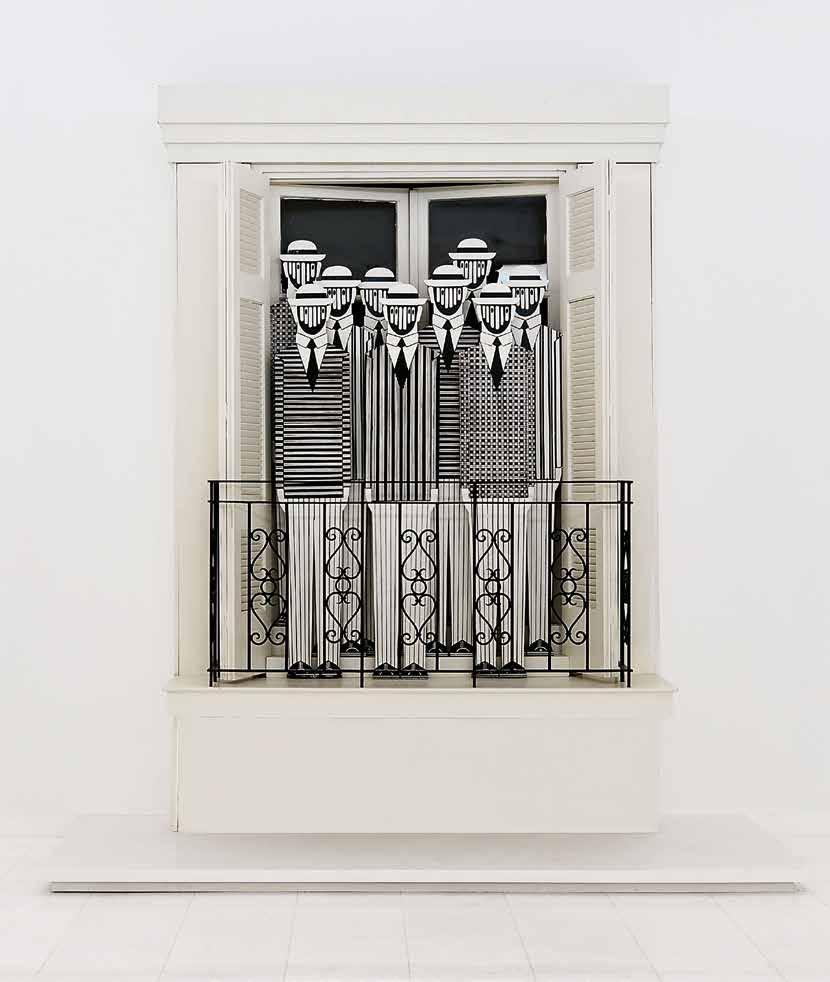
Work by Yannis Gaïtis.
Opposite page: Gabriella Simossi, “The Shadow that Builds”, 1973.
Γιώργος Καραμίχος Yorgos Karamihos

“We have to let things flow”
THE POPULAR ACTOR TALKS ABOUT HIS NEED FOR PERIODS OF REST AND RELAXATION, MODERN ALIENATION AND UNCONDITIONAL LOVE.
H
ΒY ASTEROPI LAZARIDOU , PHOTOS: ANDREAS SIMOPOULOS STYLING: SOPHIA TSAKIRI, GROOMING: MORFE
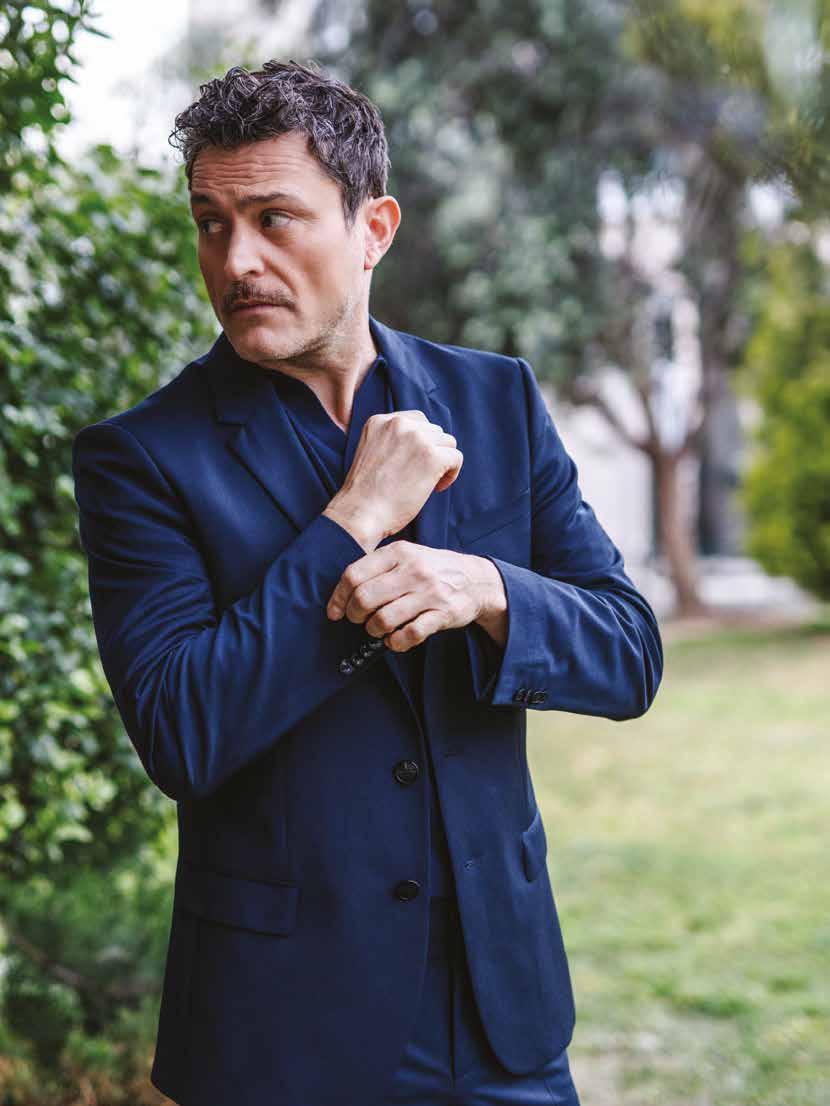

Ηe teaches acting in Greece and America, translates plays that resonate with him, directs and, of course, plays lead roles. Yorgos Karamihos is a versatile talent who fortunately knows how to take time when he needs it to regain his strength and avoid burning out. In between appearances in internationally produced TV series and films of the highest calibre, such as the recent ‘Kabul’, and performances that sell out theatres, the popular artist spoke to us about the importance of letting loose, his plans for the future and his favourite summer destinations.
What does summer mean to you?
Rest or alertness?
In recent years, my summers have been very happy. During my childhood in Veroia, summers meant a lot of work. In the fields we had, I did a lot of things, non-stop. For several years after that, due to this impetus, I would overload my schedule with work. Theatre, filming, all together. After turning 50, I finally decided to take the time I wanted. I avoid long tours, I like doing things with my son, my family, my friends.
What are your favourite summer destinations?
Nisiros has a special place in my heart. I visit every year. I enjoy life there and the volcanic waters. I also love free camping in places like Halkidiki and Samothrace. And of course the Cyclades are one of my favourite spots on the map. Paros is an absolute must for me. I spent a lot of time there last year shooting a foreign series and loved it. I discovered heavenly beaches where you can be almost alone, even in the middle of summer. The food is excellent, the quality hasn’t gone down at all. It is not pretentious at all.
What are the key ingredients for the ideal summer holiday?
The landscape, the company and the food. If one of the three is missing, you’re not having a good time.
Earlier this year you achieved great theatrical success with Simon Stephens’s “Vanya” at the Greek Art Theatre Karolos Koun, directed by Alexander Raptotasios. Will this continue into the next season?
It will be performed in Athens from mid-October to mid-November, as well as in other parts of Greece and abroad. I loved this play, I’m alone on stage, but I’m not really alone at all. Eight roles take turns, the roles from Chekhov’s masterpiece “Uncle Vanya”. I am very fond of this writer. I see him as the direct successor of the an cient Greek tragedy. He shows us what archetypes would look like in the era of psychoanalysis. Unfortunately, I have seen him butchered too often in Greece. On the one hand, there’s the academic, dusty approach that refuses to accept that there’s comedy in his work -when you go to laugh, something grips you. On the other hand, they approach him with supposed modernism in order to be innovative, ignoring the fact that this was done in the German theatre 50 years ago. This is sensationalism, a “director’s mania” that I personally find very boring.

Chekhov’s heroes suffer and speak of their loneliness. Is loneliness also a scourge of our times?
Of course it is. Emotional disability is all around us. Relationships are becoming more and more difficult. Whenever you feel any kind of sympathy, one of the two sides will snap, because they will be frightened. Solidarity requires an intimacy that most people are not prepared to feel. But it is through the other that you are called to endure and discover yourself. And yet everyone makes excuses and walks away.
It is not only love that has been affected by this alienation, but also friendship...
Our generation, and perhaps even the younger ones, have set a bad example when it comes to friendship. We mistakenly thought that by drinking, spending and the fleeting indulgence, we became friends. We are friends when we have fun, when we take pictures, when we go out...
Has social media played a role in all this?
Absolutely! I often like to observe behaviours. I am amused by the hidden messages or responses that people try to give to someone through a H


post or story. For example, you see someone posting a selfie and writing something suggestive and you say, oh, now they’re flirting, now they’re broken up, now they’re in love. Now people are caught up in the thought “Have they seen my story?”. The goal is not for the other person to see your story. The point is, do they want to see you?
Are you planning anything new in the theatre for next season? I’ll be directing “Eugene”, an Irish play, starring Evelina Arapidi, Sophia Seirli, Takis Sakellariou, Marlen Saiti and Harry Iliadis. I first read and translated it in 2006. I was supposed to direct it in 2007; it didn’t happen for other reasons, then it was planned for 2010; there was a thought last year; but finally this year is the time.
Your relationship with this project seems to be karmic... We have to let things flow until their time comes. Anything done under pressure is a liability. Even if it’s successful, you’re too exhausted to enjoy it. When there is strong resistance, I want to let go and not insist.
What are your plans for this summer?
I decided to allow for long breaks. I definitely want to take a month off in the summer. The whole of the month of August is free for holidays. I need these breaks to keep the material I use in my art fresh. So as not to resort to the same intonations, the same conditions. After a certain point, I didn’t want to go through the madness of filming and performing in a theatre again. I did it for many, many years, it was a huge energy drain and it always ends in burnout. At the same time, I am grateful that all these years I have been able to make a living from my work. This is not easy for actors in Greece. And when we go into other fields, for example dancers, it’s even more difficult. There is no state provision, nor is there the right attitude. In our country, we have yet to get over the ill-intentioned use of the word “actor - actress”.
In addition to your passion for your art, your love of animals is an integral part of your life. What has your relationship with dogs, these wonderful creatures, taught you?
Thanks to the unconditional love they give, they overcome the lack of love they suffered from until they came into your life. Stray dogs, as abused creatures, if you give them love, they overcome the abuse -they leave it behind, they don’t crave it. On the contrary, people learn to love and be loved through abuse. A person might crave a slap in the face to rub salt in their wound. At some point I realised that it was also difficult for me as a human being to move on. You have to ask yourself: why do you want to pick at a scab? Why not let it turn into a nice scar? A nice badge of honour? You could tell yourself well done for sticking it out, but let’s move on. That’s not love. It’s like wearing a shirt backwards, putting it on as it is, wrinkled. So that’s what the dogs I’m honoured to have in my life have taught me and continue to teach me. This freshness. They face the world every day with the same longing. The way the dog reacts to the walk is unique every time. And then there is the quality time we spend cuddling on the sofa. The scenes of jealousy they cause when they see you concentrating on your phone and not on them. They take your hand and turn it back to themselves so you can pet them. I’ve learned this precious freshness from dogs. That unconditional and unspoken love.
We would like to thank Theta Athens All Day Restaurant & Cocktail Bar (11 Adrianou Street, Athens 105 55, theta-athens.gr) for their hospitality.

Τα παιδία… διακοπάρει!
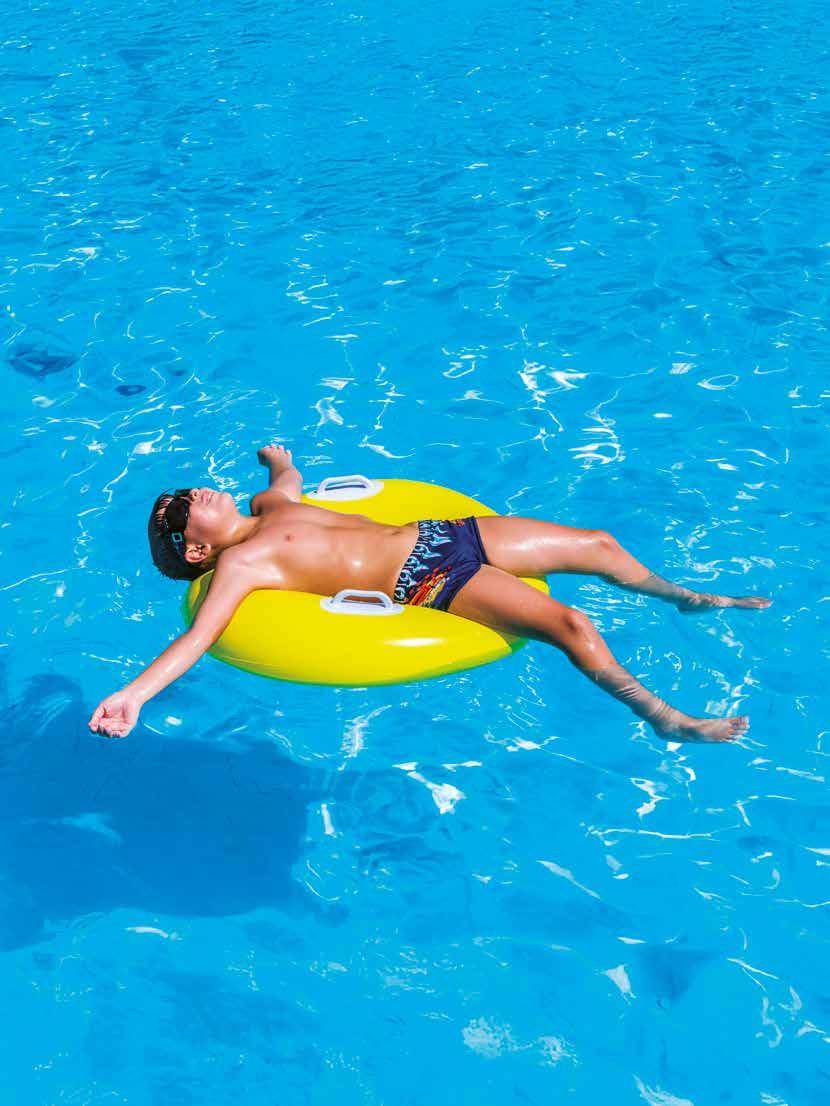
TRIANTAFYLLOS TRIANTAFYLLAKOS, A CHILD PSYCHOLOGIST FROM TINOS, EXPLAINS HOW IMPORTANT IT IS TO ALLOW CHILDREN TO LET GO AND FILL THEMSELVES WITH IMAGES AND EXPERIENCES, TO EXPLORE AND CREATE, SHOWING ADULTS THE WAY TO A LOST, CAREFREE YOUTH.
BY ASTEROPI LAZARIDOU
THhe first time we swam without arm bands; counting ice creams and baths in the sea; playing impromptu games with new friends until dark; the carefree nature of summer holidays and the relaxed face of our parents; are all components of childhood happiness that have been written into our DNA. Child psychologist Triantafyllos Triantafyllakos (MSc in Child Development, Diploma in Montessori Pedagogy) explains why, just like adults, children need time to relax and unwind during their summer holidays.
Just how beneficial can the summer holidays be for a child’s mindset?
Absolutely beneficial! I think most of us have in mind a typical vision of our childhood holidays. This vision often fuelled our resilience for the entire school year, like an emotional battery.
Let’s think of development as a puzzle made up of five basic pieces: cognition, language, motor skills, emotions and social skills. Holidays provide children with the opportunity to practise all these skills effortlessly and experientially, equipping them with valuable life tools. Children learn new customs and traditions, come into contact with other cultures or regions of their homeland and enrich their vocabulary with new words. They run, touch, climb, swim, get excited and happy, discover things and meet other children who may become their new friends.
Compared to the daily life of children of previous generations, today’s children lead much busier lives. How important is it to slow down during the summer and what role do parents play in this?
It’s true that today’s children have much less free time! They run from one activity to the next with no time to rest or get bored! However, boredom is necessary for creativity.
Summer provides the free, unstructured time that children need. It is important to slow down the pace so that children can experience their time in peace; think about what they really enjoy; be able to experience beautiful moments without time pressure; learn spontaneously through exploration, with inner motivation; rather than following the instructions of a structured extracurricular activity once again.
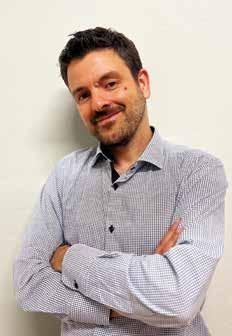
Parents are responsible for their children’s leisure time. Although there are indeed many good extracurricular activities, children cannot participate in all of them every day. We need to exercise moderation. The same level of moderation is needed in summer. The pace must slow down so that children can devote time to caring for their bodies, mind and mental needs. They need to sleep well, be fed properly, be allowed to play and explore, and spend quality time with their parents.
As adults, we tend to expect a lot from our summer holidays, wanting them to be a time for relaxation and unwinding. Does this also apply to children now?
Unfortunately, summer holidays are now

treated as the magic wand that will banish all problems. However, since there are no magic wands, problems do not simply disappear. We cram so much work, pressure and stress into the eleven months before the holidays, on which we then rely to help us unwind. But this does not work, neither for us nor for our children. The fast pace of life, pressure and stress can take their toll on the body and soul.
Children are asked to go to school, complete the exercises in their handouts, take tests and pass exams. They also attend activities and then quickly return home to tie up any loose ends. “We don’t have time” and “hurry, we’ll be late” are more resonant than “I love you” and “what do you need?”.
Summer is great, but it can’t solve everything. We need to put the brakes on. To reduce the pressure on children throughout the year, to reduce the endless activities and to allow them time to rest and produce their own thoughts and projects.
How important is it to try to keep children away from screens during the holidays? Based on your personal experience, do you think children’s imagination tends to shrink or change due to their heavy reliance on technology?
It’s important for children to have a healthy relationship with screens throughout the year. Otherwise, the problematic relationship with screens, or even dependence on them, is simply magnified during the summer. Nowadays, children are exposed to endless images, videos and information that they are unable to filter effectively. They are passively bound to a device that knows exactly how to adapt its content to keep viewers engaged. But let’s think about it, what else could they be doing on holiday instead of staring at a screen? How many opportunities to play are missed?
Children’s imagination needs stimulation to develop. The screen stifles the imagination because it provides ready-made worlds. Rather than being asked to produce an original idea, children are trapped in a universe of advertising that promotes new products to them. Furthermore, the imagination can be distorted when exposed to ageinappropriate stimuli.


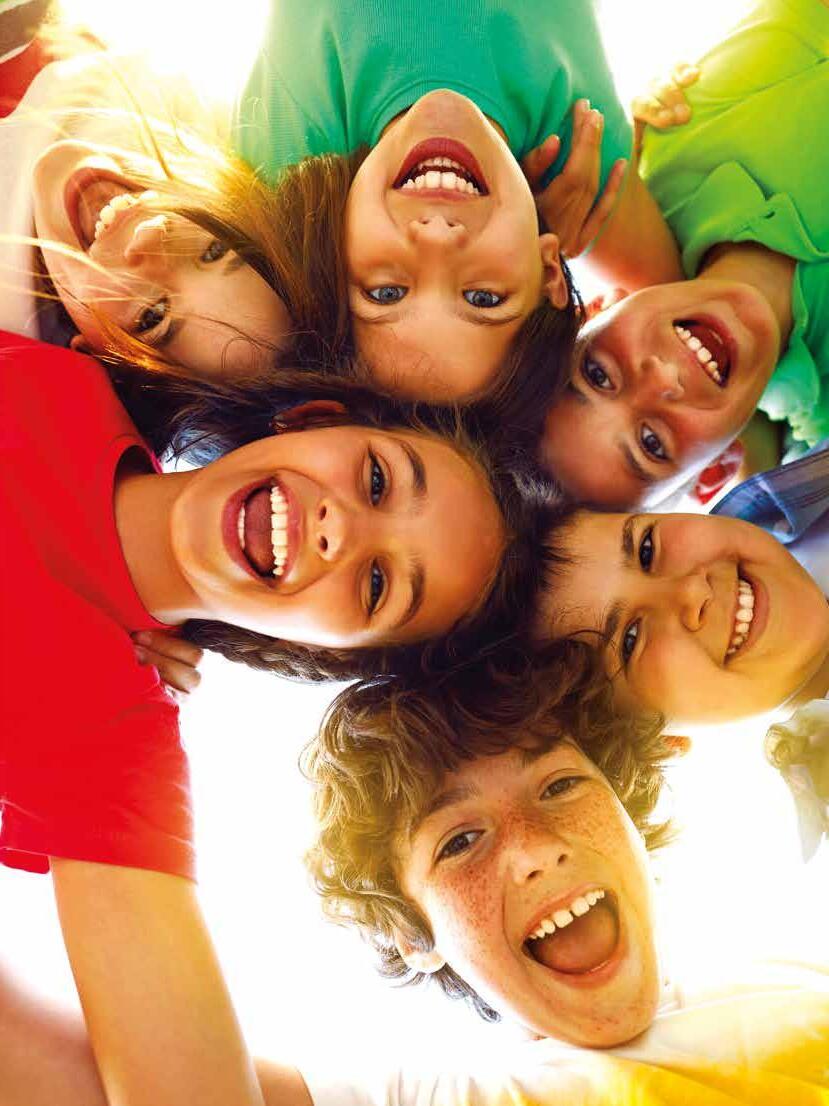
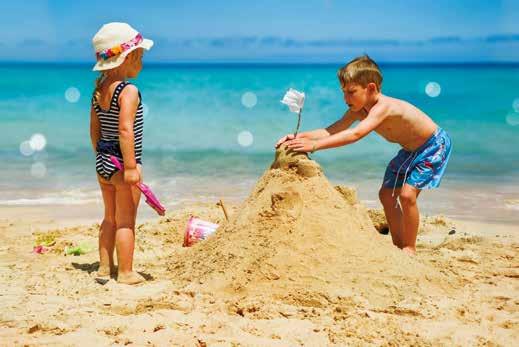
Ultimately, does summer make us all feel a little closer to our inner child?
No matter how old we get, summer will always make us feel young again! It is a time for leisure, for disconnecting from routine and obligations. You are more spontaneous, free to think, to exercise, to laugh, to share moments with your own people, to listen to music, to dance, to feel. You are becoming a child again, so you must protect and preserve that for your own children.
You come from Tinos and specifically from Volax. Which are your favourite spots in the island? Would this be an ideal place for a child to make unique summer memories that would stay with them into adulthood?
It is a place that I love very much. When you experience it as a child, you take it for granted. But once you grow up, it becomes valuable. A refuge for the body and the soul. I have many favourite spots: the view when I turn onto the road and catch sight of Volax, the sunset from Ysternia, the square with the plane tree in Pyrgos, the waters of Malli, the alleys in Arnados and Triantaros and walking through Kardiani.
It is an ideal place for children. There is sea to swim in and mountains to climb. It is a beautiful place that gives children the opportunity to engage with art and architecture. Children are fascinated by the variety of villages, each of which has something special to discover, local flavours to taste, and friendly people with many stories to share!



Can the summer heat affect the thyroid and the symptoms of thyroid disease?
Excessive heat can cause:
● Dehydration, affecting the absorption of thyroid drugs.
● More severe symptoms in hyperthyroidism, such as worsening of tachycardia, heart arrhythmias, increased sweating, increased nervousness/anxiety, decreased tolerance to heat, etc.
● More severe symptoms in hypothyroidism, such as worsening of fatigue/drowsiness etc.
Are thyroid operations performed during the summer months?
Summer is not a reason to avoid performing thyroid surgery. The hospital stay is only one day, with the patient being discharged the day after the operation. Postoperative pain is minimal (treated with paracetamol) and does not last long. Recovery is rapid, with an immediate return to daily activities, provided that intense physical stress is avoided for a week. The incision heals within four days, after which the patient can wet it and bathe in the sea while taking the prescribed measures to protect themselves from the sun. The patient can eat whatever they want from the day after their operation. Therefore, the timing of the operation depends on the type of thyroid condition (i.e. how urgent the thyroid removal is) and the patient’s preferences. Summer is not a contraindication for the operation.
What can I do over the summer to avoid further thyroid problems?
It is useful to follow these guidelines:
● If you take any thyroid medication, try to be consistent with both the medication itself and the dosage regimen.
● Make sure you drink enough water every day to avoid dehydration, which is common in summer due to sweating.
● Avoid sun exposure during the hottest hours of the day (12:00-16:00).
● Stay in a cool, shaded place and use air conditioning if necessary.

● Choose light, cool clothes in light colours.
● Follow a balanced diet and avoid heavy meals.
● You should see your doctor if your symptoms worsen or new ones appear. A simple blood test to measure thyroid hormones can help determine whether your thyroid is responsible for your symptoms. If thyroid hormone levels deviate from normal limits, it is highly likely that the patient’s medication dosage (levothyroxine for hypothyroidism or antithyroid medication for hyperthyroidism) will need adjusting.
Georgios Sakorafas, MD, PhD Thyroid - Parathyroid Surgeon, Assistant Professor of Surgery at the University of Athens, Coordinating Director of the AGIOS SAVVAS Surgical Clinic, HOSPITALS: EUGENIDEIO Hospital - Athens Medical Group PSYCHIKO CLINIC - MITERA Hospital
Email: georgesakorafas@yahoo.com, www.gsakorafas.gr
MiLEP Minimally invasive Laser Enuclation Prostate
MiLEP Minimally invasive Laser Enuclation Prostate The revolution of minimally invasive prostate nucleation.
Men notice changes in their urination as they get older. This is due to the development of an adenoma within the prostate gland. In the vast majority of cases, it is benign tissue with no functional contribution. All it does is obstruct the free flow of urine, leading to symptoms familiar to middle-aged men such as reduced ease of urination, frequent urination, nocturia and urgency, incontinence and even inability to urinate. All these start as simple discomfort and develop into a major problem that requires medical intervention. This otherwise benign condition is responsible for a significant proportion of surgery in men over the age of 55, with considerable medical, family, professional and financial costs.
Over the years, the surgical community has progressed and continues to explore less painful and less traumatic ways to treat this benign condition. This advancement led to the complete adenoma enucleation by Holmium Laser (HoLEP).
Over the past decade, it has become the gold standard in the treatment of Benign Prostatic Hyperplasia (BPH).
• Bloodless procedure. Patients who receive anticoagulation therapy for serious reasons, where stopping would put their life at risk, can have surgery! Previously, this group had to be informed about long-term hospitalisation and be prepared for the risk of bleeding by obtaining blood for transfusion.
• A definitive solution. Complete, rather than partial, removal of the adenoma, as is the case with the widely used diuretic (TURis) procedure. No residual tissue is left to grow in the future. So the old advice given to surgical patients that they would be fine for 7 to 10 years is no longer the case. After HoLEP, men no longer have to worry about urination!
• Treats all patients. The limitations imposed by gland size on other methods do not apply to HoLEP. It treats the huge 300cc glands as well as the much smaller ones.
• Short hospitalisation. One overnight stay at the clinic.
• Rapid recovery. Within a week men have returned to their normal activities.
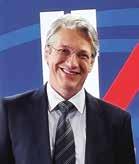
The endoscope has become thinner and therefore “friendlier” to the sensitive urethra, so we have:
• Avoidance of urethral trauma with rapid rehabilitation.
• Accuracy within the surgical field as we flexibly and precisely direct the powerful 150 watt laser to ensure ideal separation of normal and pathological tissue.
A common and widespread male problem is entering the MiLEP era.
Nikos Bafaloukas Director of the 4th Urology Clinic, Prostate & Nephrolithiasis Laser surgery at IASO www.ourologia.eu
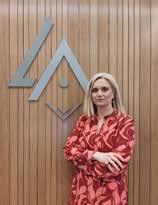
Summer has finally arrived and it’s time to relaxing on one of the beautiful Greek beaches. Being organised always helps avoid surprises that could spoil our holidays.
What is good to have in our suitcase:
● Cotton underwear that lets the body breathe.
● At least 2 swimsuits to change into after a swim, so that they do not dry on us -fungus love heat and humidity!
● Beach towel -we never sit on the sand, rocks or sunbeds without one.
● Intimate soap, vaginal probiotic suppositories to maintain normal flora, vaginal chamomile douche (in case of irritation, it will ease the symptoms until we get proper treatment from our doctor) -if we are sensitive to fungus, boric acid suppositories twice a week are a lifesaver.
Erotic spirits are high during the holidays, but don’t forget to use a condom to protect yourself from sexually transmitted diseases and unwanted pregnancy. Showering and urinating after sex also helps to prevent urinary tract infections. Don’t forget to drink plenty of water. If there is a history of cystitis, soda, cranberry probiotics and D-Mannose may provide some protection.
Avoid swimming pools and jacuzzies (bacteria thrive there). Our body’s defences are also weakened by sweets, soft drinks and alcohol.
When pregnant , carry with you your vitamins and a note from your doctor stating the week of pregnancy and any special needs. It is a good idea to research the facilities for pregnant women at your destination. In the first trimester, nausea may worsen on board: small meals, crackers, Chios mastic, banana, ginger and special herbal remedies could help. In the third trimester it is advisable to travel close to the maternity hospital and make sure that there are frequent connections.
After vaginal birth , if there is a sense of looseness and the area is more open, you could also be susceptible to infection. Laser vaginal tightening and muscle strengthening with electromagnetic waves will protect you.
In the menopausal years , the dryness and urogenital atrophy weakens the defences and makes you more susceptible to infection. It is important to moisturise the vagina before the trip, ideally with laser, hyaluronic acid or special products.
We always have our social security number and have activated paperless prescriptions so that our doctor can prescribe medication in case of an emergency.
We don’t forget our sunscreen and, of course, our good spirits.
Have a happy and carefree summer!
Antonia Lazaraki Obstetrician - Gynaecologist Surgeon, operates and performs vaginal births at IASO Athens, as well as at MITERA. lazaraki.gr
Science leads the way. Precision defines the care.
Minimally Invasive Spine Surgery (MISS) and endoscopic techniques represent a breakthrough in the treatment of spinal conditions -offering precise, safe, and faster recovery solutions for patients. The Endoscopic and Minimally Invasive Spine Surgery Clinic at IASO General Clinic, led by Dr. Georgios Vastardis, MD, PhD, is a certified Center of Excellence and an international training hub, welcoming spine surgeons from around the world to master advanced techniques.
MISS procedures are performed through tiny skin incisions (~1 cm), using local anesthesia and causing minimal tissue damage. Techniques include transforaminal injections, disc nucleoplasty, endoscopic discectomy, endoscopic rhizotomy, endoscopic foraminal and central decompression due to spinal stenosis -delivered with exceptional accuracy and minimal trauma. A key innovation is the combination of endoscopy with robotic-assisted navigation. Advanced systems like O-arm and raobotic platforms allow surgeons to plan and execute each intervention with utmost precision -placing screws and interbody cages through percutaneous or endoscopic methods, even in complex spinal fusions. Stable spinal fractures due to trauma, osteoporosis, or other conditions can be treated with percutaneous kyphoplasty -an internal fracture repair performed without the need for blood transfusions. Patients typically mobilize independently just hours after surgery. Most procedures are completed within a few hours, with same-day discharge. Patients return to their normal routine quickly, without the prolonged recovery often associated with open spine surgery.
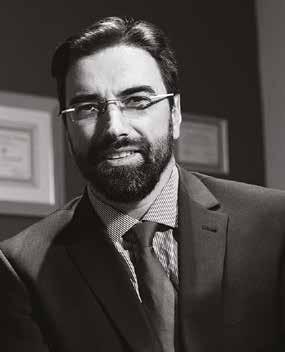
Every treatment is evidence-based and personalized. Following a step-by-step approach, our team aims to achieve the best possible outcome with the least invasive method and the least amount of postoperative pain.
Dr. Georgios Vastardis MD, PhD, Spine Surgeon, Chief of Endoscopic and Minimally Invasive Spine Surgery (M.I.S.S.) Clinic, IASO General Clinic, IASO Group, Athens, Greece Facebook, LinkedIn, Youtube: Endospinehellas www.endospinehellas.gr
DISCOVER THE MOST ADVANCED METHOD TO TREAT THE PROBLEM AND GET RID OF IT WITHOUT PAIN, SURGICAL INCISIONS AND POST-OPERATIVE SCARS.
Both varicose veins and spider veins are signs of venous insufficiency. The earlier venous insufficiency is recognised and treated, the lower the risk of complications. The most common test to diagnose the problem is the vascular triplex. Varicose veins, in particular, are treated for aesthetic reasons, but above all for medical reasons, such as the risk of thrombosis.
There are modern methods of treating these problems that are radical and successful. We’re talking about lasers, of course. Especially for varicose veins, the intravenous laser is a spectacular technological development which, by using optical fibres, makes it possible to treat any type of vein with very low energy levels, painlessly, with absolute precision, in a very simple and effective way, minimising the possibility of intra- and post-operative pain, bruising and other adverse effects. The treatment is performed under ultrasound guidance, without hospitalisation, under local anaesthesia and lasts 30-45 minutes.
Specifically, the laser energy is diffused radially through the optical fibre to the walls of the vein, where it exerts a targeted photothermal effect that completely seals the vein. The above procedure requires no incisions or stitches and leaves no scarring. Patients experience little or no pain during or after the procedure and can return to normal activities immediately.
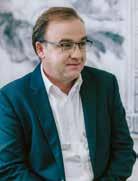
As for spider veins, they are now treated with the latest generation of lasers, which work externally, shrinking the veins in question and causing them to disappear permanently. Thanks to this new method, injections and various chemicals, which until recently were the only solution, are being used less and less or not at all.
George I. Rokas Vascular Surgeon - Angiologist, Director of the Vascular Surgery Clinic of Metropolitan Hospital, Faliro. www.angiologia.gr
THE MAKO® ROBOTIC SYSTEM HAS BECOME THE LEADING SYSTEM FOR PERFORMING HIP & KNEE ARTHROPLASTY.
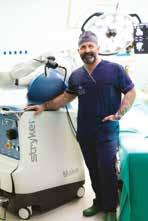
Conventional arthroplasty relies heavily on the experience of the surgeon, manual instruments and visual assessment during the operation. Although these traditional methods have provided satisfactory results, they have some limitations in terms of accuracy of osteotomies, correct implant placement and soft tissue balancing. These factors can affect the long-term results of surgery, such as the lifespan of the implant and the functionality of the joint.
With the advent of robot-assisted orthopaedic surgery -and in particular the MAKO® system-, arthroplasty is one step closer to perfection.
The MAKO® Robotic System has brought a radical change in overcoming the key challenges of each patient’s unique anatomy and the general difficulty of treating worn surfaces. This technology combines advanced imaging, sophisticated preoperative planning tools and robotic precision to enhance the surgeon’s ability to perform knee and hip arthroplasty procedures.
MAKO® Technology: How does it work?
The MAKO® system uses computed tomography (CT) to create a 3D digital model of the patient’s anatomy. This personalised approach allows the surgery to be planned precisely before entering the operating room. The key elements of the system are:
● Preoperative planning software: Allows detailed planning of osteotomies and implant placement according to the patient’s anatomy.
● Robotic arm with haptic feedback: Provides haptic, auditory and visual feedback to guide the surgeon within pre-defined limits.
● Real-time intra-operative feedback: Monitors and adapts to any changes during surgery.
During the operation, it is important to point out that the robotic arm does not perform the operation autonomously, but works as an assistive tool under the full guidance of the surgeon. Essentially, the system restricts the surgeon’s movements within the planned limits, preventing deviations from the surgical plan and protecting the surrounding tissue. This reduces the possibility of injury to the muscles around the joint, allowing for faster recovery and better function.
A growing body of literature points to several important benefits of MAKO® robotic arthroplasty, including increased accuracy, faster recovery and less post-operative pain, less soft tissue damage, less bleeding and shorter hospital stays.
BSC (HONS), MBBS (HONS), MD (RES), PHD, FRCS (TR & ORTH),
| The Athens Clinic Panagiotis D. Gikas BSC (HONS), MBBS (HONS), MD (RES), PHD, FRCS (TR & ORTH), Consultant in Robotic Hip and Knee Arthroplasty and Musculoskeletal Oncology
LEFKOS STAVROS | The Athens Clinic pgikas.gr
The wrist, with its complex anatomy, the diversity of the injuries and the inability of precise identification of the pathologies consists the “black box” of the upper extremity. “Key” to “unlock” this region is the wrist arthroscopy.
The wrist is the third more common joint to be involved in arthroscopy, after the knee and the shoulder. As in the above-mentioned joints, a very small camera, smaller than 2,5 mm, is introduced in the joint allowing direct vision of the internal part of the wrist and accurate identification of its pathologies. It also gives the ability to introduce small instruments of respective caliber that allow not only the process of diagnosis, but also the therapeutic intervention. As a result, ligament pathologies, ganglia, fractures, pseudarthroses, avulsions, impingements and other pathologies are being identified with high precision, allowing the treating physician to select the most appropriate method of management.
During the last 25 years, the functional anatomy and the pathology of the Triangular Fibrocartilage Complex, which is situated within the wrist joint, has been identified. The TFCC, as it is commonly mentioned, is an anatomic structure, which is important for the application of forces in the hand, especially during the rotatory movements. Pathology of this structure, with tears being the most common, makes more difficult the daily function of the hand, not only in hard labor but also in simple daily activities. Wrist arthroscopy allows us accurate identification of these lesions, as well as precise management of them, providing solution in problems that could not be handled earlier with success.

Nikolaos P. Zagoreos MD MSc Orthopedic Surgeon
Wrist arthroscopy consists an important weapon in the armamentarium of the modern orthopedic surgeon and especially of the hand and upper extremity surgeon. It requires good practical mastery of the different arthroscopy instruments and techniques, as well as excellent knowledge of the anatomy and the pathology of this complex region, something that can be found in orthopedic surgeons specialized in hand surgery.

In recent years, dental science has changed dramatically thanks to the integration of advanced digital technologies. CAD/CAM (Computer-Aided Design/Computer-Aided Manufacturing) systems and Artificial Intelligence (AI) applications are transforming the design and manufacture of dental restorations.
What is CAD/CAM?
It is a digital system that enables dentists to design dental restoration (such as crowns, bridges, inlays and implants) on a computer before producing it with the help of a special cutter or 3D printer. First, the teeth are photographed using a special scanner. These images are converted into digital models, and the prosthetic construction is then created virtually with the help of special software. At this stage, the dentist can make adjustments to the shape to achieve a better result. The software then sends this data to a cutter or a 3D printer where the 3D design is converted into a product (crown, veneer, inlay, onlay, bridge, implant case).
How can Artificial Intelligence help?
Artificial Intelligence facilitates personalised design, i.e. the creation of restorations tailored to each patient. More specifically, it uses the information collected by the scanner from each patient’s mouth, along with large databases, to accurately and aesthetically design the restoration we want to build.
Advantages for the patient and the dentist
Fewer visits: The treatment often takes just one day, or even one hour, to complete.
There is no need for traditional imprints with “clay”. Digital scanning is a more comfortable and precise method.
Greater accuracy: Digital imprinting reduces errors compared to traditional methods, ensuring an excellent fit and aesthetic.
Better communication: Using digital models makes it easier for dentists, dental technicians and patients to understand and collaborate with each other.
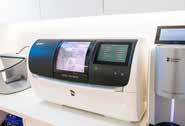
A more natural result: New materials and greater precision produce more beautiful and long-lasting “smiles”.
The future is digital
Technology is evolving every day and so is the care we receive. Excellent work that is both aesthetically pleasing and precise can be carried out quickly, often within an hour and without the need for temporary restoration. A new world is opening up in the future of dental science.
Vicky Deligeorgi PhD, MSc, DDS, Dentist specialised in Aesthetic and Reconstructive Dentistry
DAiscover Mykonos life and hospitality, its stunning emerald-blue waters, the dazzling sunsets, while enjoying a relaxing environment and high quality services.
Ideally located 50 meters from the beach of Ornos, near the heart of Mykonos, Hotel Dionysos features 45 beautiful rooms and suites, 2 outdoor swimming pools, satellite TV 42”, WiFi Ιnternet access, guaranteeing unique comfort. dionysosmykonos.com


The history of the business began in 1973, when Pantelis Antonakakis opened the Antonakaki Optics store. In just five decades, it has earned the trust of the people through honesty and quality service. Today, the second generation, Katerina and Kostas, are continuing the family business, combining years of experience with studies in Optics and Optometry in Greece and abroad, as well as making use of state-of-the-art equipment. Our priority has always been, and continues to be, to provide you with the best possible service with a smile and a positive attitude! www.antonakakioptics.gr

Silky Skin presents the new Silky Skin Sugar Body Scrub, a luxurious 200 ml body scrub that upgrades your daily beauty routine by combining natural exfoliation with intense hydration.
A top-of-the-range body care product designed for all skin types, with natural sugar granules as its main ingredient to gently remove dead skin cells. Their combination with nourishing oils and moisturising agents
leaves the skin silky, radiant and revitalised.
Removing dead skin cells improves the skin’s texture and prepares it for more intensive care. silkyskin.gr

